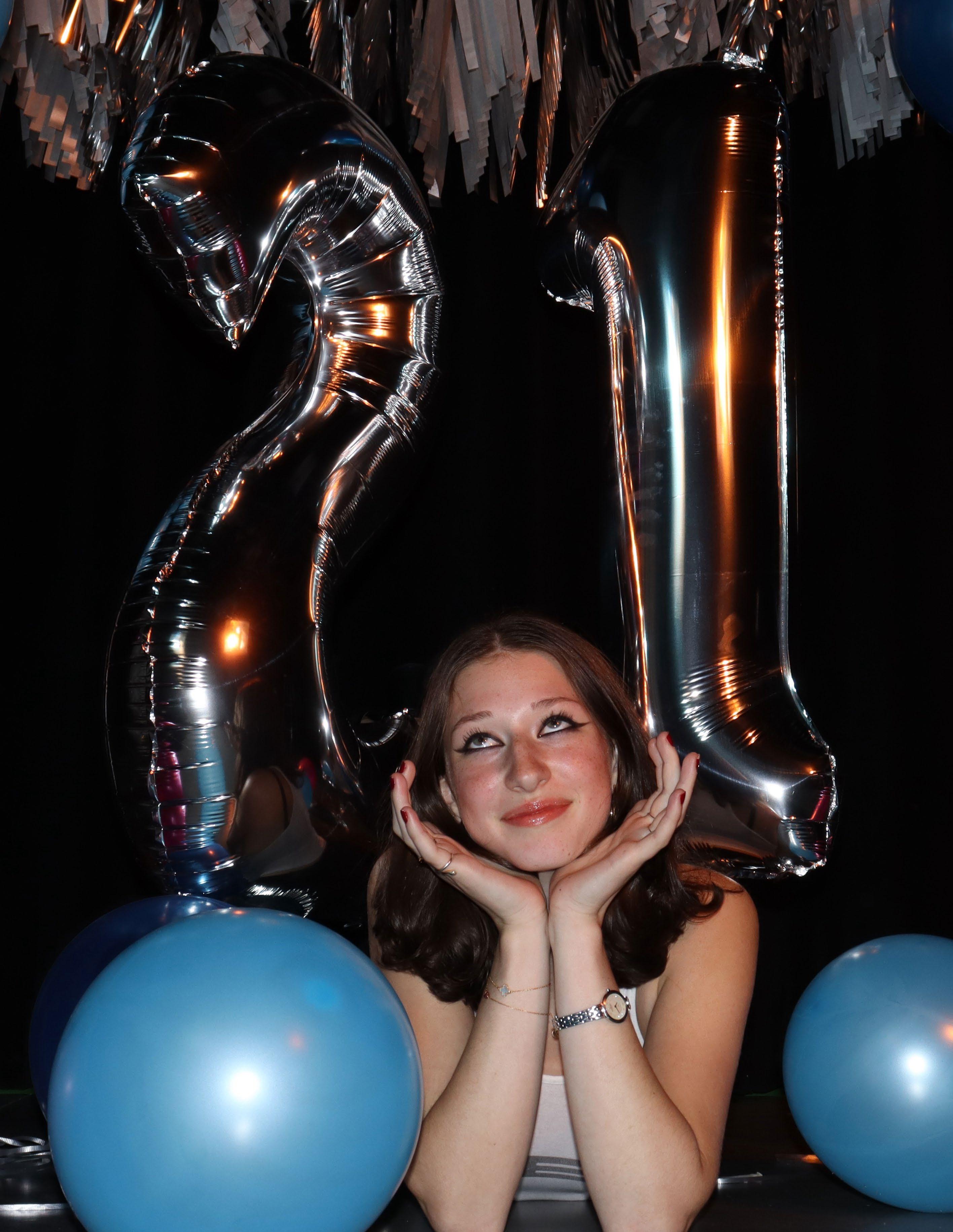




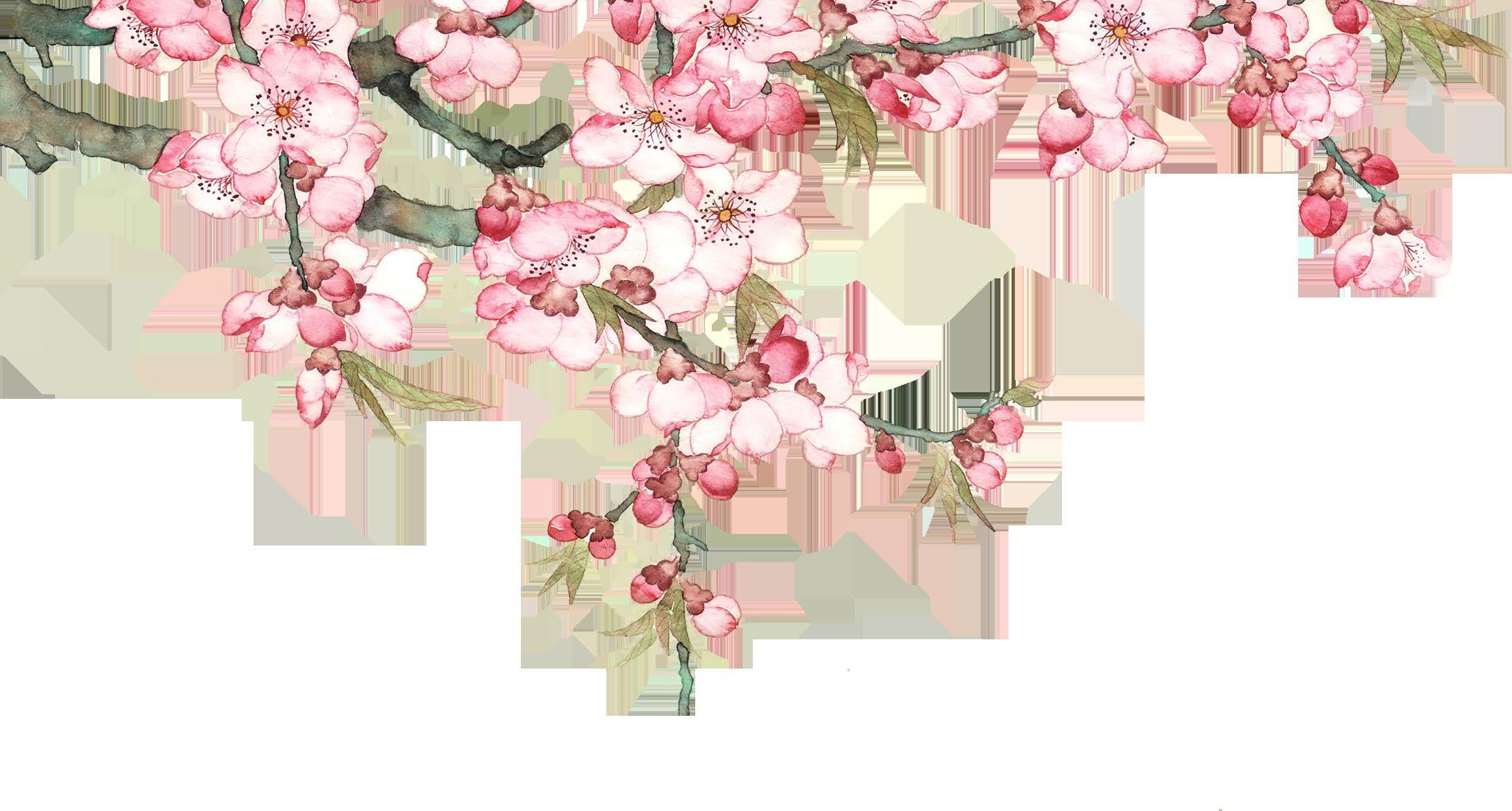
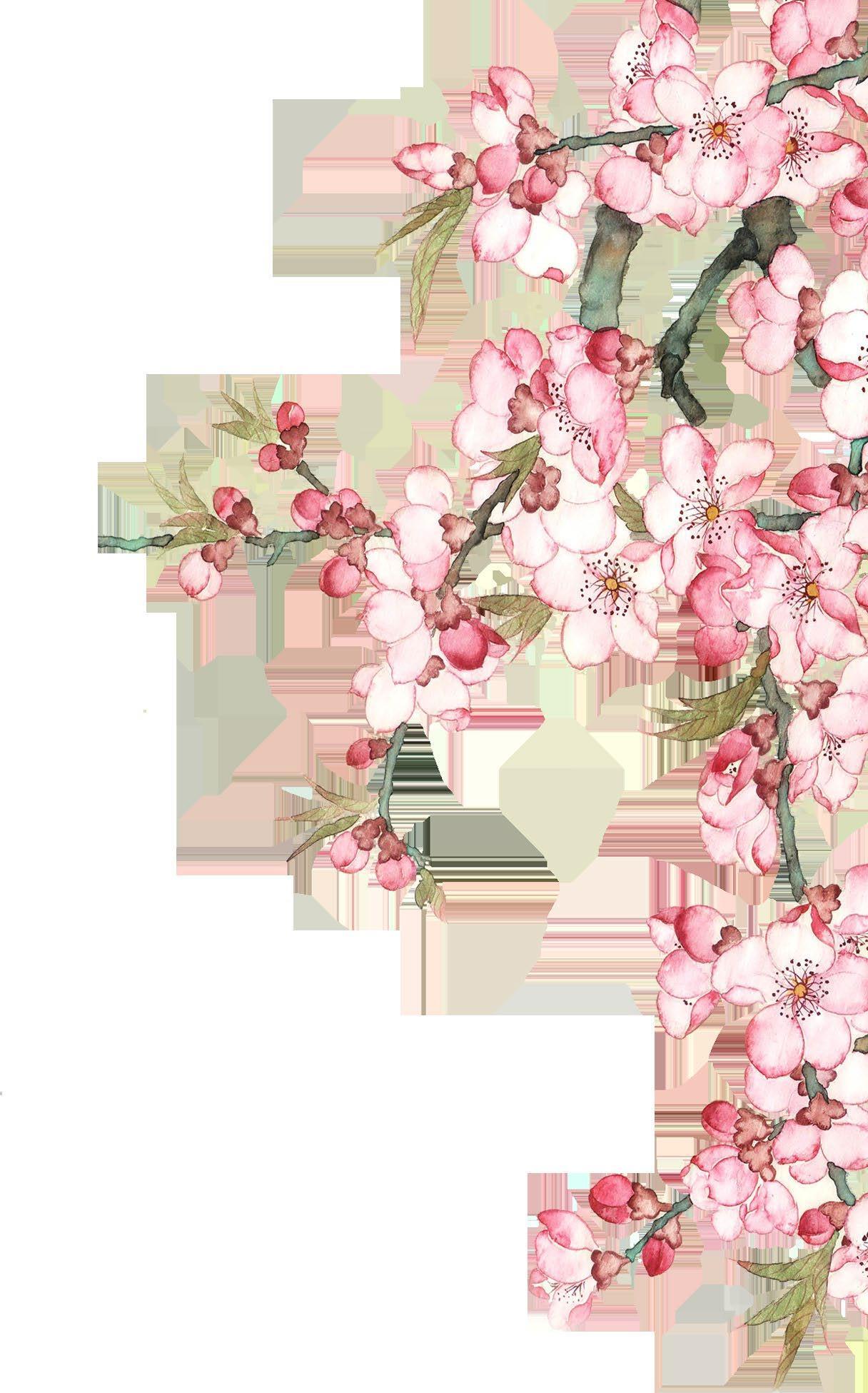
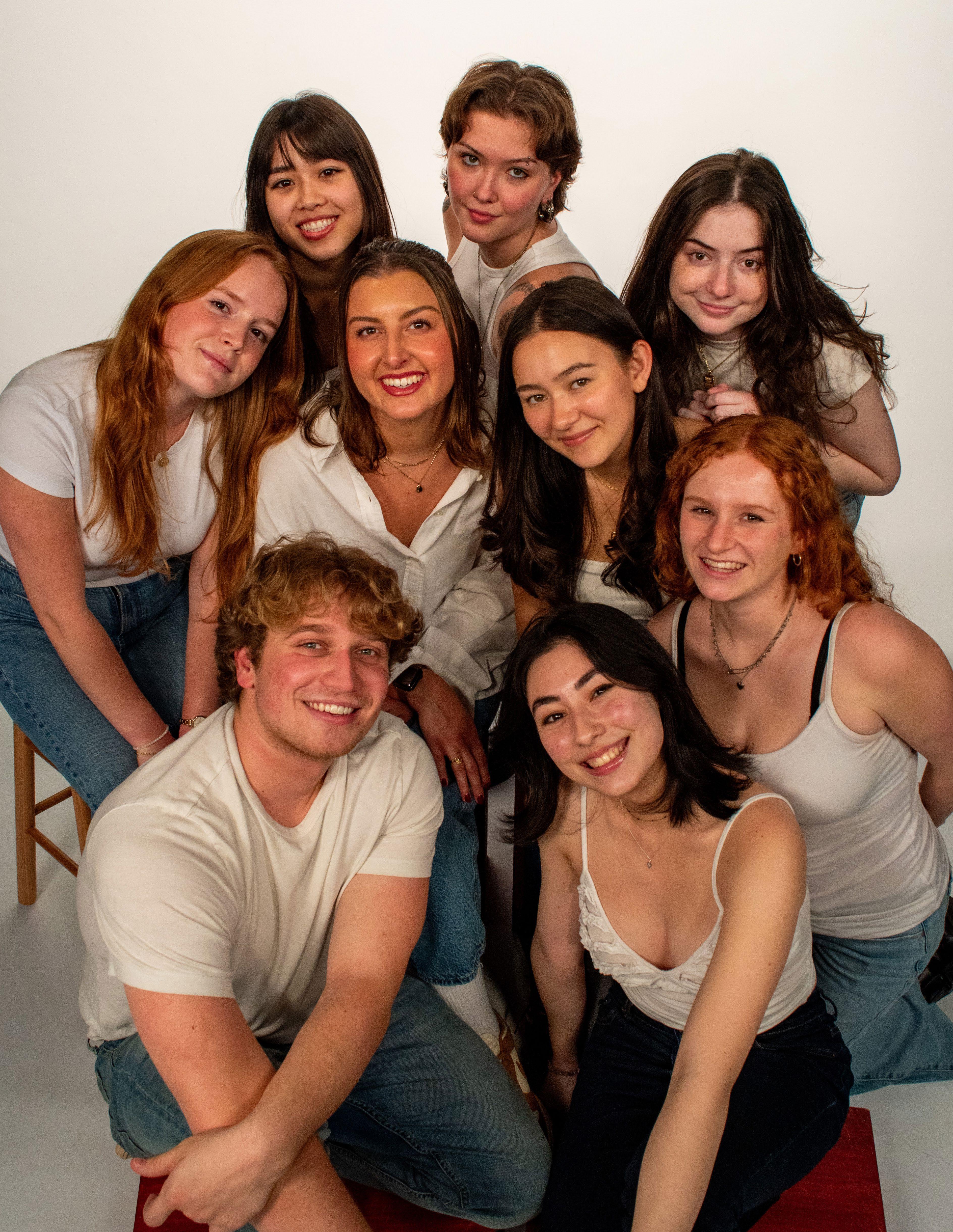
Co-Editors in Chief
Managing Editor
Beauty Director
Editorial Director
Head Stylist
Layout Director
Photography Director
Visual Media Director
Hana Dolan & Sophia Viscarello
Ilana Frid-Madden
Abby Lowder
Sadie Chase-Tatko
Ella Strasser
Sawyer Kron
Amanda Sedaka
Mia Piscitani
Writers Stylists
Beauty Team
Models
Photographers
Layout Designers
Photographer: Norbu Lhendup
Norma Callejas, Emma DiGiacomo, Bryna Jekogian, Lamia Karabegovic, Camille Lurie, Katrina Nelson, Hadley Noonan, Ignatio Tran
Anny Chen, Esther Choi, Charlotte Clark, Owen Dimock, Iman Rahman, Smrithi Menon, Arielle Schultz, Sarah White
Abigail Lowder, Emma Henderson, Sri Masturzo, Paige O’Hara
Steph Andrade, Taima Ashour, Hanna Bauman, Helen Bradfield, Cathy Carlson, Maddie Cloutier, Leslie De La Rosa, Hana Dolan, Alex Finch, Jayden Fedoroff, Jazmine Florencio, Maria Ioannou, Lev Janicki, Eric Li, Lleyton Mendieta, Edwin Mensah-Boateng, Meraly Morales Tula, Mina Morcelo, Teja Singh, Ilsaa Siddiqui, Christina Stoll, Benjamin White, Cooper Xu, Kate (Hpoo) Yadi, Palmer Yongka Yerima
Kathleen Blass, Anthony Ozoria, Norbu Lhendup, Gori Goto, Linh Tran
Sawyer Kron, Bayley Dickinson, Madison Butler
We’re so excited that you’re here to celebrate Sig Style’s 21st with us! After nine incredible years of fashion, creativity, and collaboration, reaching our 21st issue feels like a celebration in itself—a coming-of-age moment for a magazine that has been the heart of our campus style scene since 2015.
This issue is filled with stories and visuals that capture the energy, passion, and spirit of our community. Drawing inspiration from the cultural milestone of turning 21, we’ve channeled the essence of this moment for this issue: a celebration of our journey so far and the exciting beginning of a brand-new chapter. As this is our first issue as Co-Editors-in-Chief, we wanted to honor the visions of past EICs while putting our own personal flair and passion into every piece. From celebrating students’ cultural backgrounds to exploring expressions of fashion in our current social and political worlds, we wanted to reflect the broad effects fashion has on our lives.
We both joined Sig Style as photographers and have always had a love of the art of fashion photoshoots, where every shot frames not just an outfit, but the subtle depths of individuality and expression that give life to our campus style. Now, as Co-Editors-in-Chief, we’re continuing to channel our passion for visual storytelling through fashion, expanding our repertoire to showcase the student artistry of our models, writers, stylists, beauty artists, layout designers, and photographers. With that, we can’t emphasize enough how grateful we are for our EBoard and GBoard teams this season. Every one of our contributors worked tirelessly to bring our collective vision to life, and the final product is truly the embodiment of this passion. Our weekly EBoard meetings feel more like casual hangouts than formal work obligations, and we are SO excited to carry this energy into next semester with you all!
We would also like to give a special shout-out to Bret Olsen, Hamilton’s Manager of Academic Technology & Digital Teaching Support, for granting us photo studio access; Chloe Maldonado, Student Activities Program Coordinator, and the Pub staff and programming team for their party-planning guidance; and, of course, President Tepper for making time during his hectic first few months on campus to give us a glimpse into his signature style.
For the two of us, Sig Style is a reminder that even amidst the demands of college life, there is always space to celebrate individuality and self-expression. Fashion is an integral part of all our lives: what we wear reflects our unique identities and creativity, while also serving as a powerful vessel for empowerment and confidence in how we present ourselves to the world. We hope you enjoy perusing this issue as much as we’ve enjoyed making it.
On that note, join us in raising your glasses… Here’s to Sig Style 21!
Cheers, Hana and Sophia

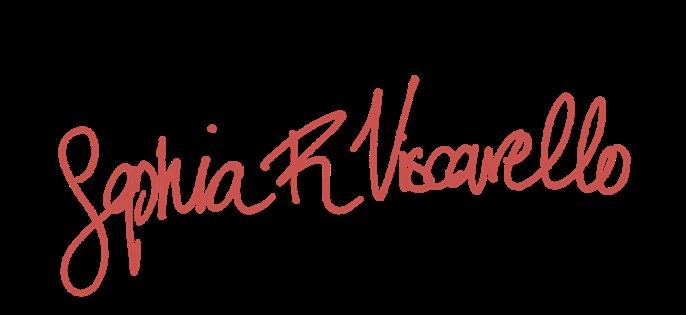
Photographer: Norbu Lhendup
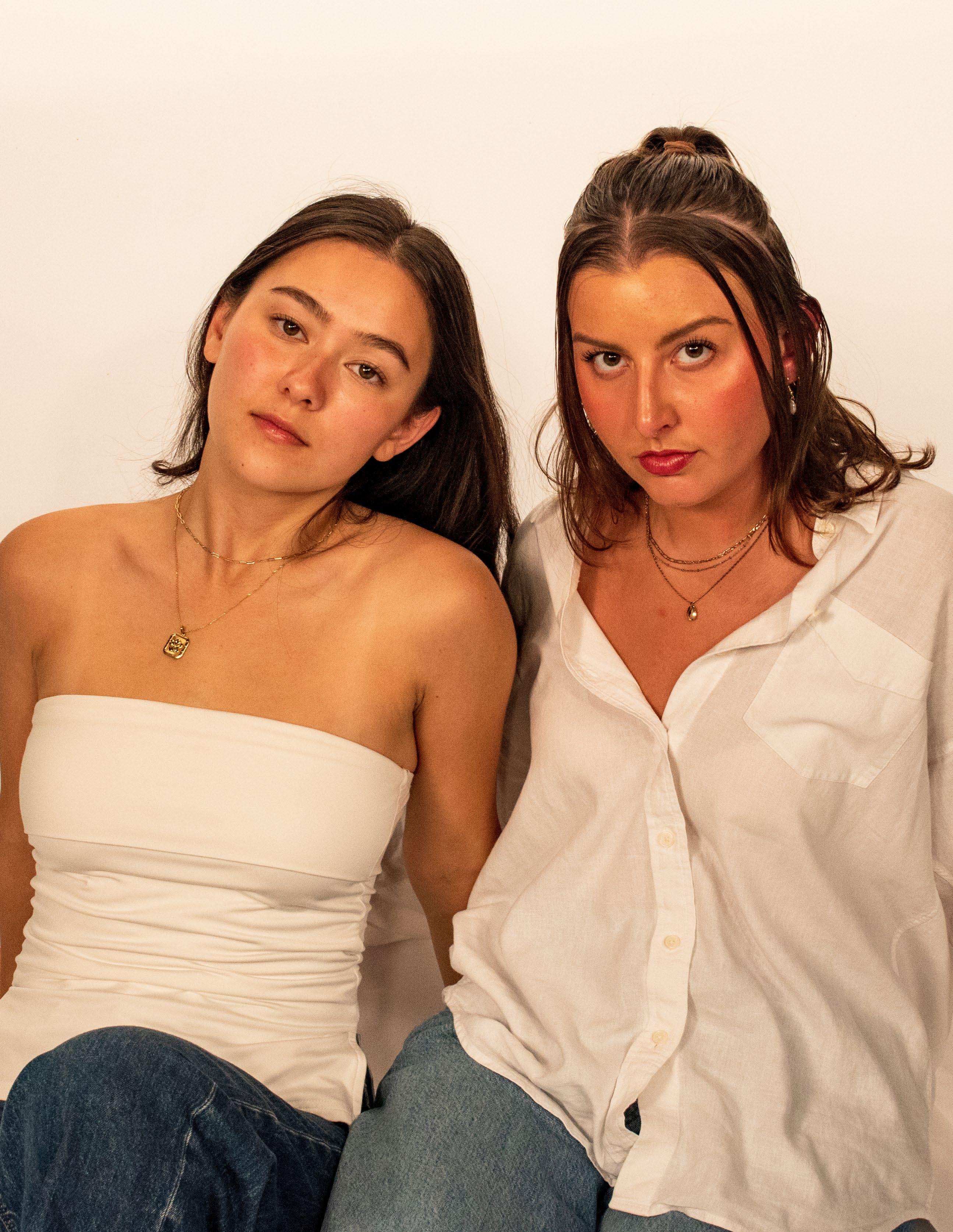





















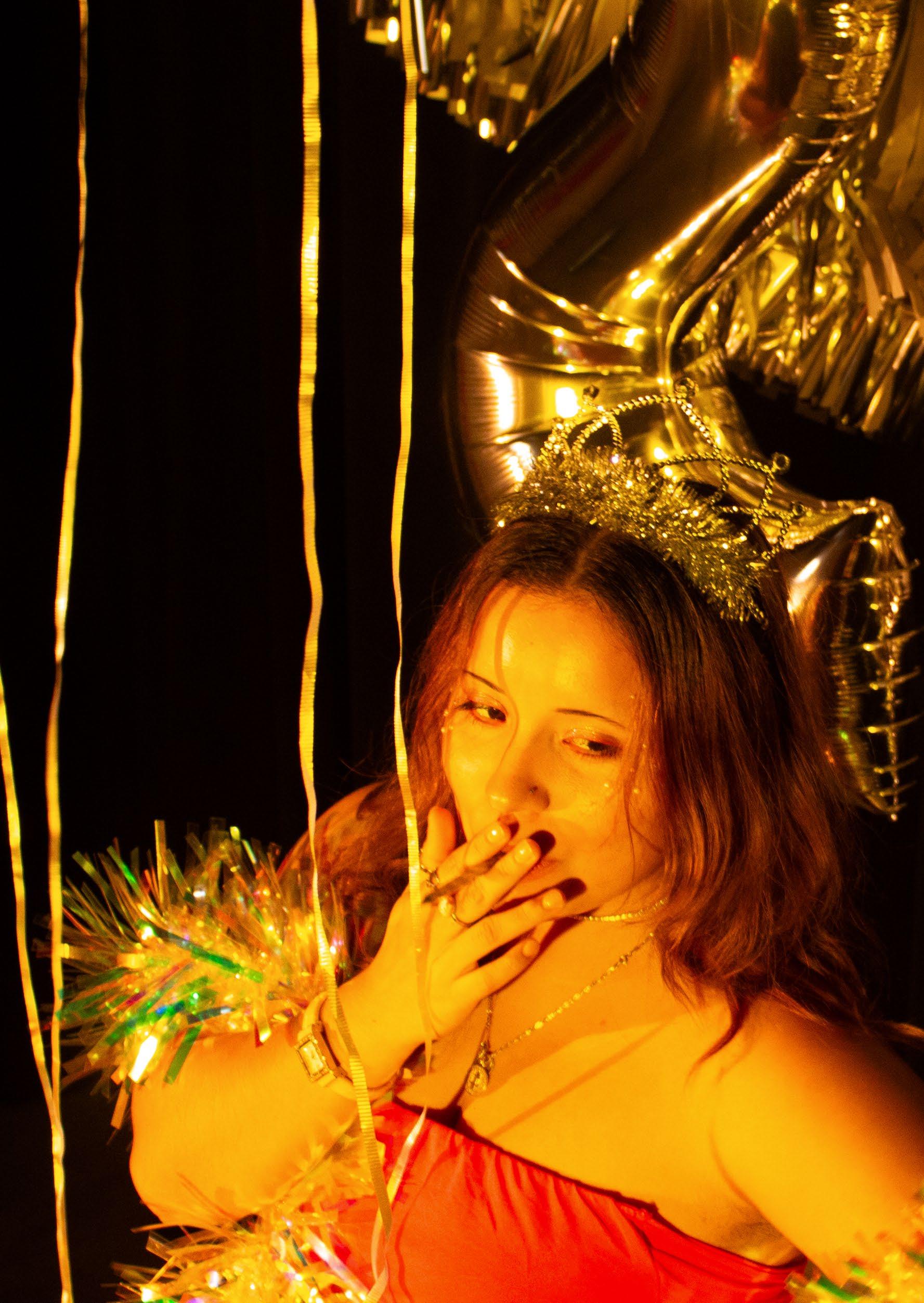

In honor of our 21st birthday, we want to reflect on how you celebrate yours! In the United States, turning 21 is a significant milestone that marks the legal ability to enter the world of adulthood: drinking and purchasing alcohol, smoking tobacco, entering nightclubs, and gambling. College marks an interim between childhood and adulthood, and for many people, their 21st coincides somewhere within that interim—the mystifying landscape between youth and maturity where people try to define their identity. Fashion is one of the most explicit ways one can explore identity and in the murky world of college, when people are stuck somewhere between an awkward teen ripe from high school and a fully independent adult, and party culture is an important aspect of entering the adult world and choosing a style. Party fashion allows one to ease inhibitions and explore styles that would not be accepted or appreciated in the daily mundanities of life.
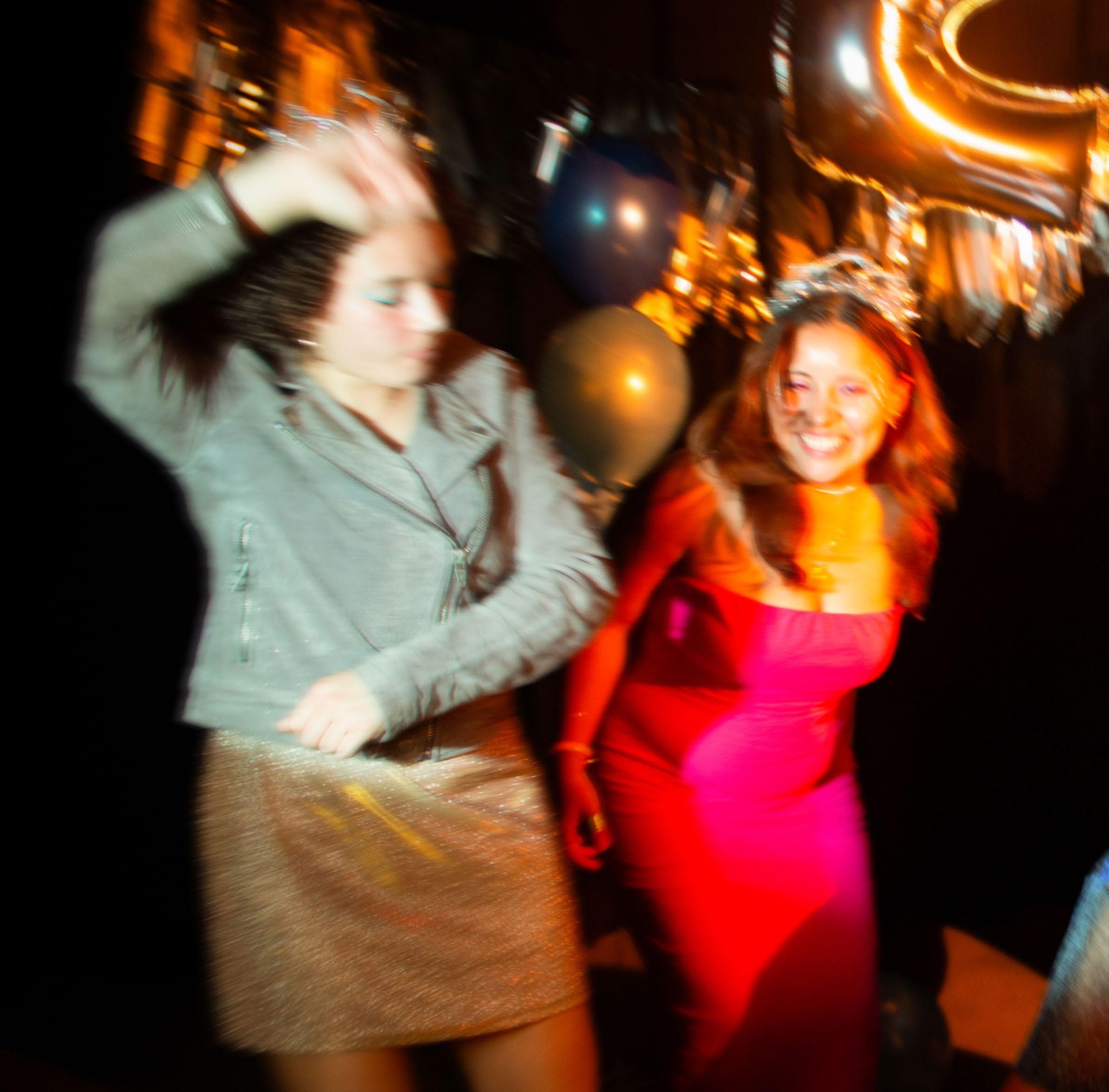
The very intentionality of going-out culture elicits a departure from routine—and therefore the fashion must, too. Bars, clubs, and raves provide a unique setting where outfits that would be unconventional for their theme, provocativeness, or bling during the day are encouraged and expected at night. For many, going-out
culture starts right at home: the night begins in the closet and in front of the mirror, perhaps with a lipstick tube in hand. Building the anticipation, confidence, and excitement of the night commences with curating the perfect going-out look. Typical nighttime looks include moody, dark colors; eye-catching and statement-creating accessories; and bold
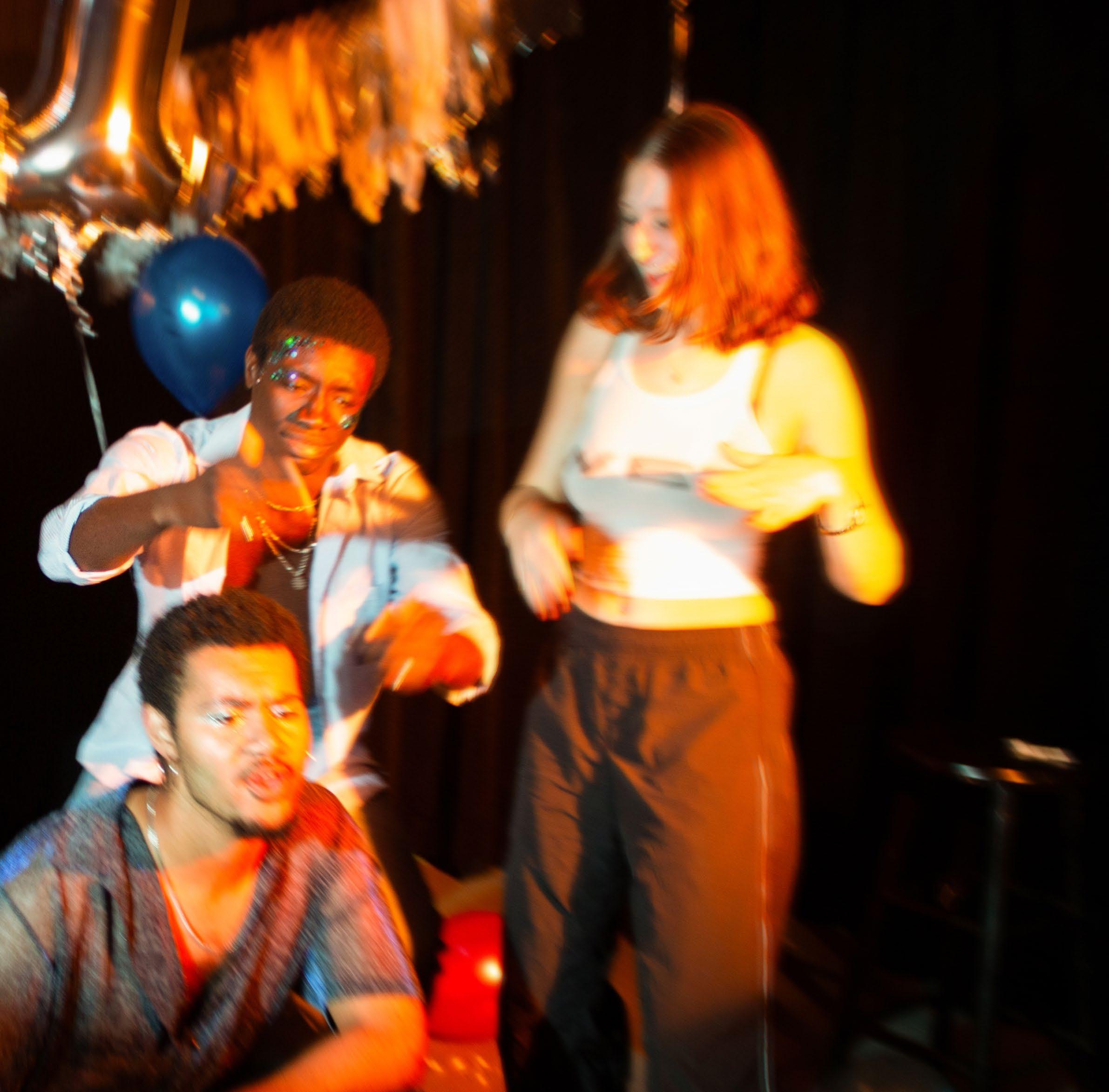
makeup, but the key to going-out fashion is departing from the often monotonous styles of daily life and leaping into a realm where anything is accepted. The preparation for going out often includes gathering a friend’s opinion on a look, peeking into closets and swapping clothes, and perhaps pregaming the night’s destination with a fun cocktail. Above all,
the fashion culture of parties, clubs, and raves allows for a more creative, confident, and outgoing version of ourselves to take a spin for the evening.

For our 21st birthday, we included the blaring fashion of party culture in our outfits. Models wore bold makeup of colorful eyeliner and glitter highlight, adopted a multitude of flashy accessories, and toted quintessential black throughout, be that a solid pair of black boots for comfortable dancing or a general theme of moody colors. More importantly, however, each model exuded a style that represented their identity, and therefore made them feel comfortable and confident with their choices, an incredibly important feat for a successful night out. Jazmine Florencio ’26, inspired by her own girly-pop aesthetic, dressed in a hot pink dress and heels. For her, party culture is “feeling excited and confident enough like that feeling
you get when you’re getting ready before going out.” As she entered the photoshoot scene, Florencio wanted to portray a hyper-feminine yet playful vibe that correlated with her all-pink aesthetic. Likewise, Mina Morcelo ’28 dressed in a glittery pale-pink dress, a gray suede jacket, knee-high black boots, and a glowing tiara. She wanted to showcase the enjoyment of “feeling pretty and having a good time” that party culture brings out within her. Morcelo mentioned wanting to keep her cool, blue eyeliner on just for herself after the shoot to continue that feeling of beauty throughout the day. With this fun look, Morcelo wanted to bring more of a sweet-sixteen vibe to the photoshoot, adding a sense of fun and a good time with the other models.
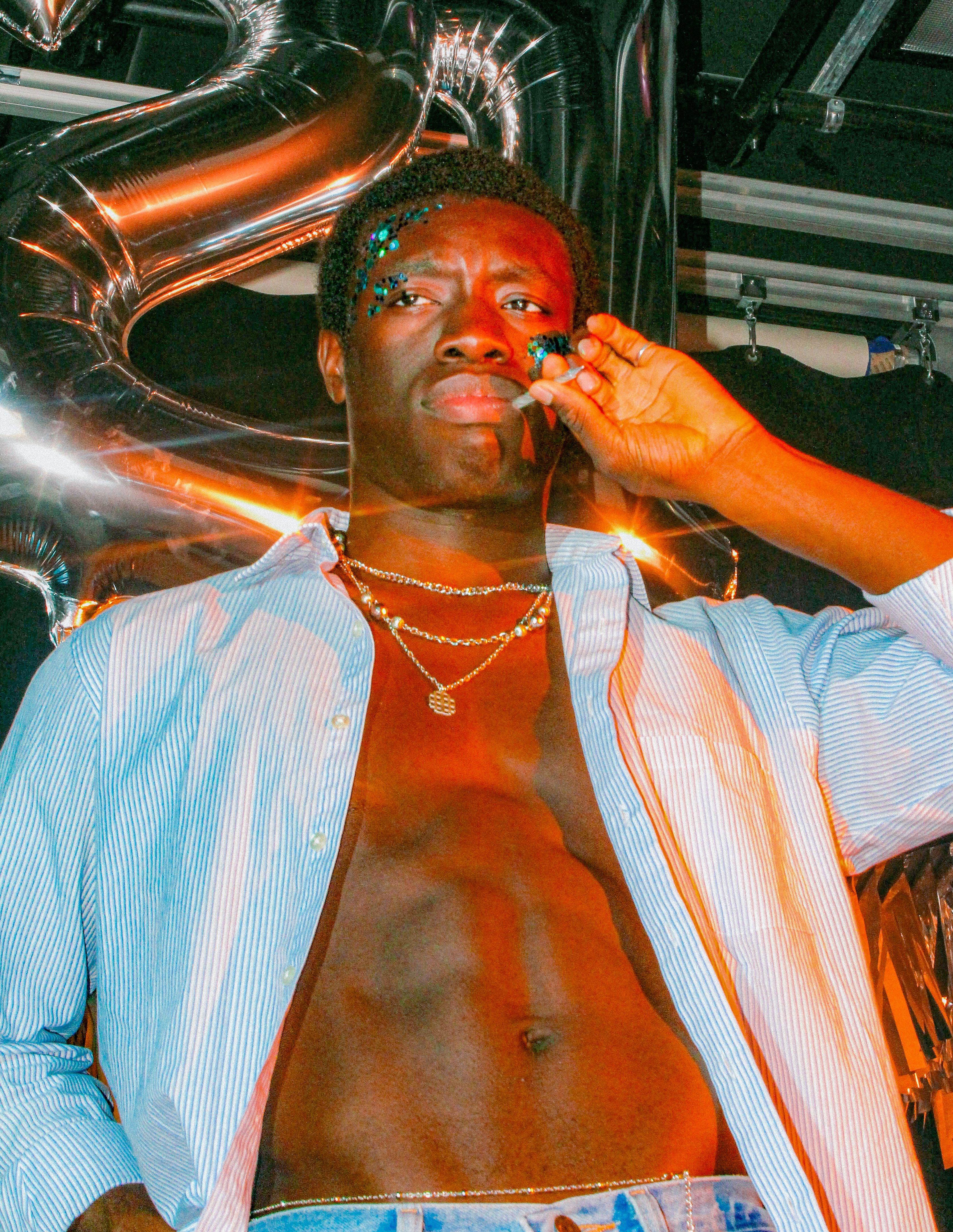
walks into every party with his head held high. White’s outfit included a sheer black and blue shirt and black cargo pants, and he accessorized with shiny metallic chains hanging from his pockets and sparkly silver eyeliner that made him feel comfortable and confident. “This is an outfit I’ve worn a lot but have styled in different ways, it’s very versatile and I feel comfortable in it,” he said. He explained that party culture for him means being with people he loves and having the

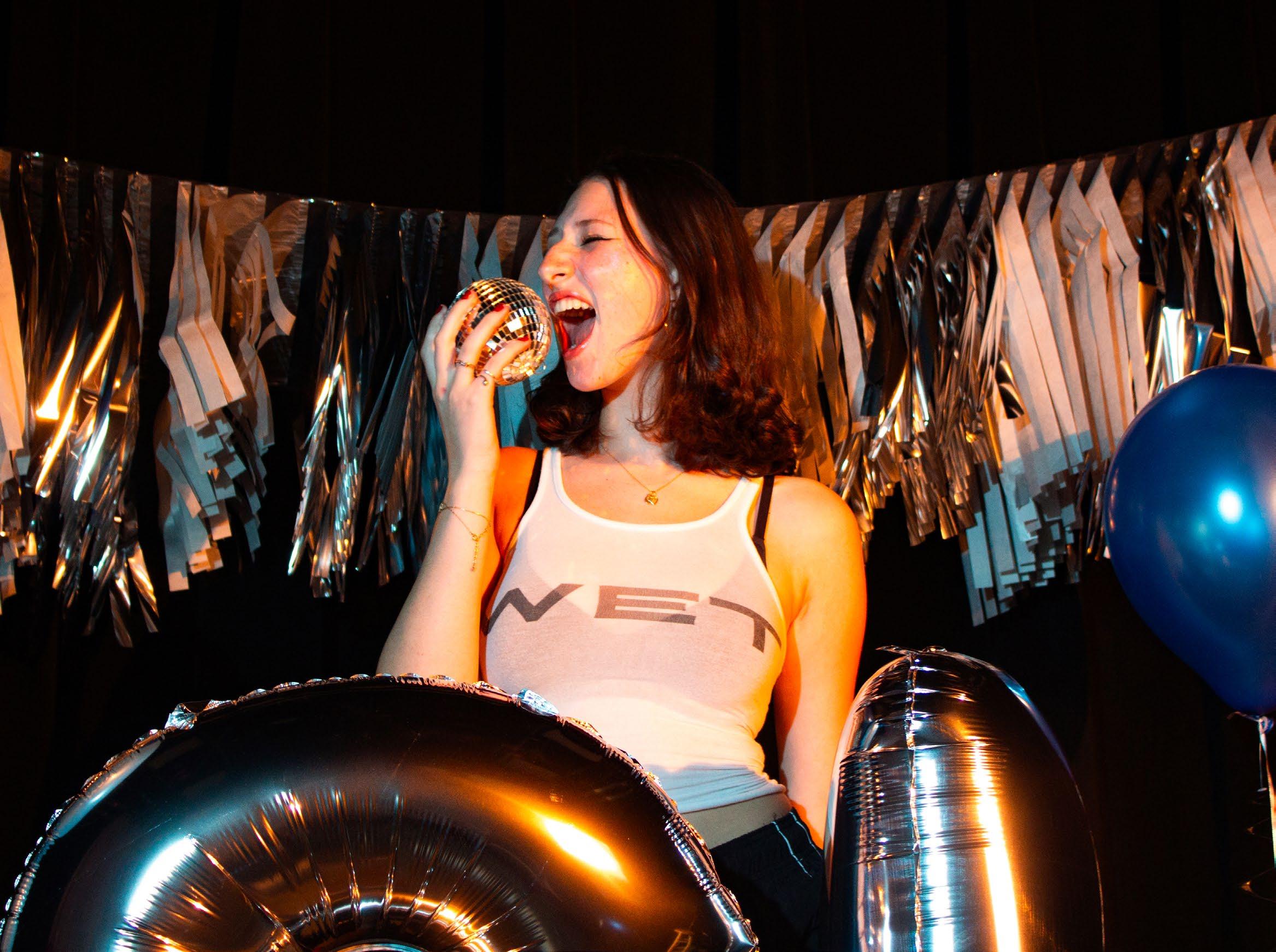
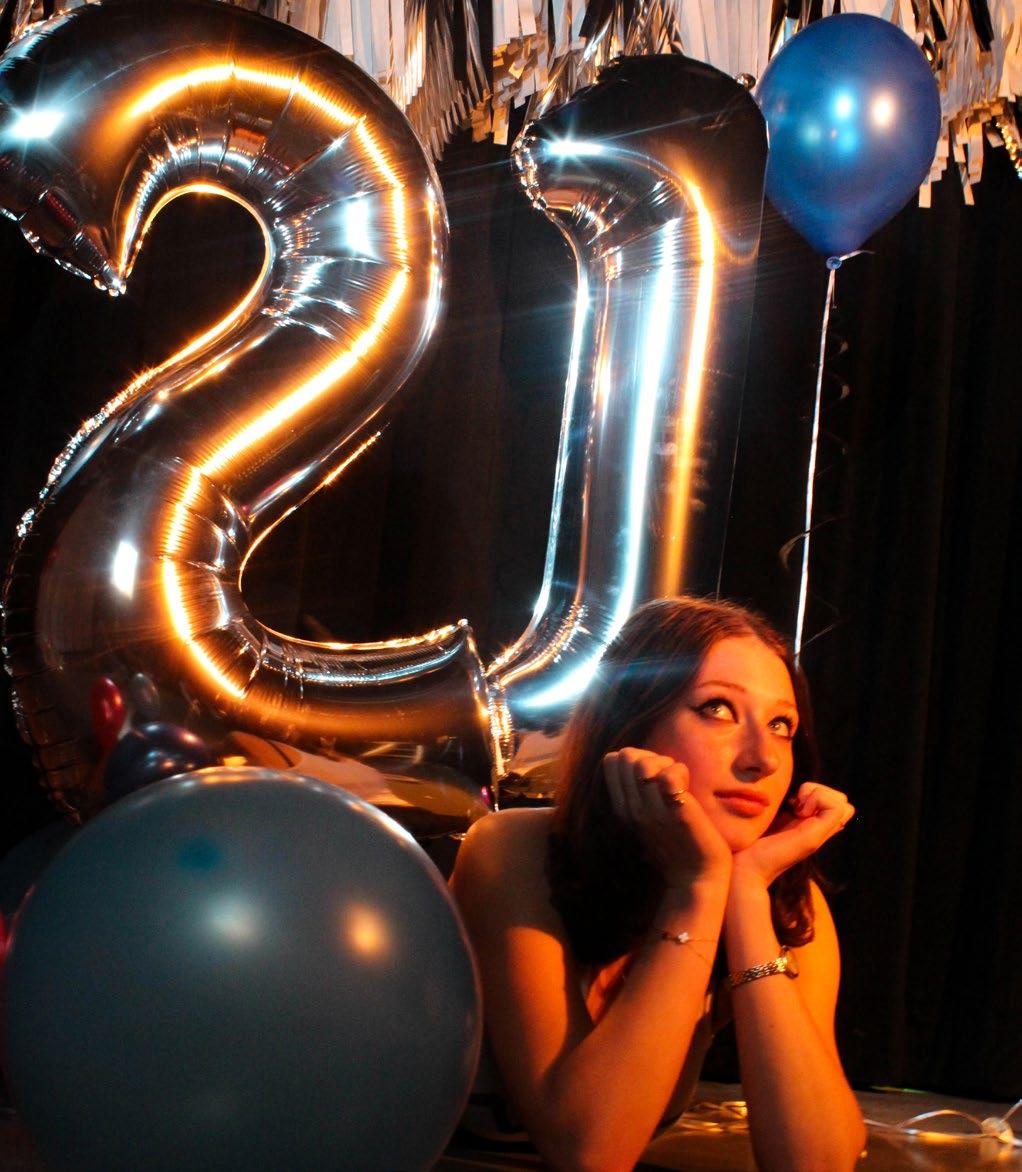
best time possible. Since he knew people at the shoot, he felt comfortable. “That is such an important thing, especially in party culture, being comfortable because then you’re free to express yourself in any way you see fit, and that’s a party in my mind,” White said. Hanna Bauman ’27 also describes party culture as “a release” and having fun with your friends and the people you bring together for one special occasion. Bauman, dressed in a thin white graphic tank with the word “WET” on the front and black track pants with reflective silver stripes running down the sides, wanted to bring more

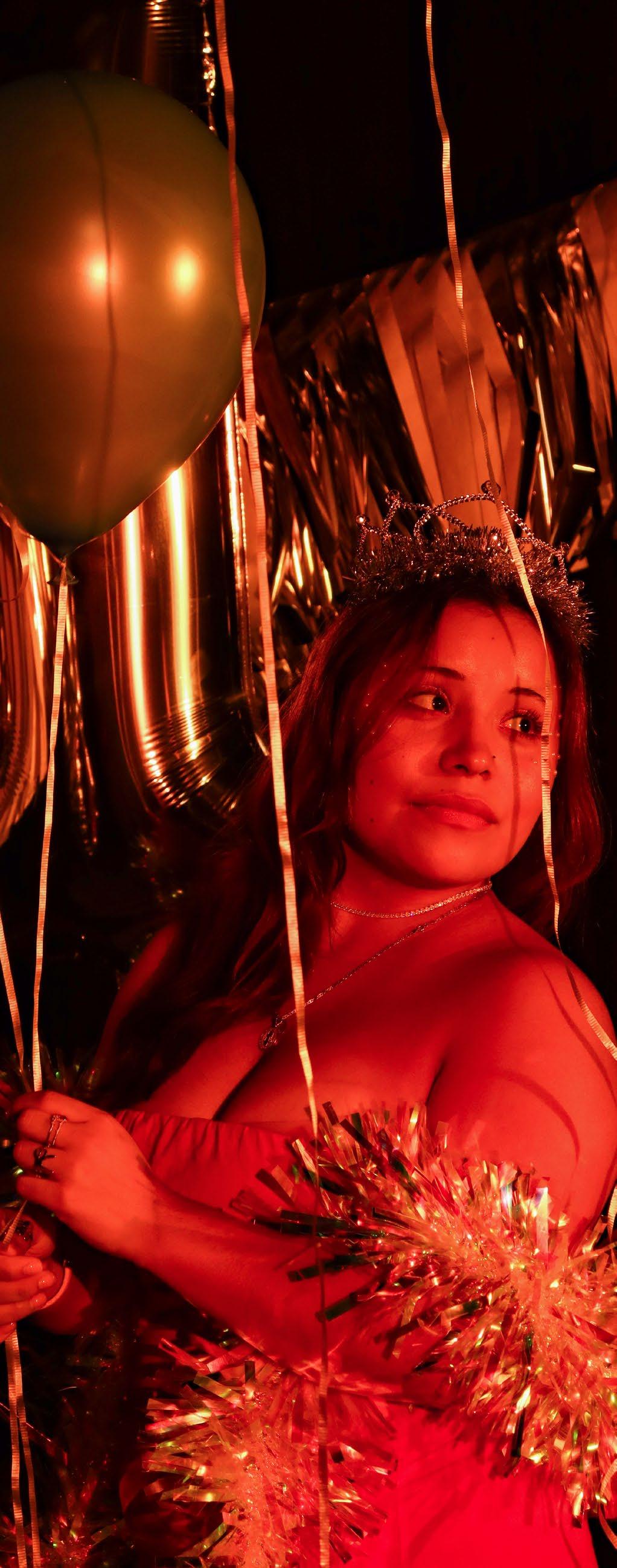
of a stereotypical club look to the photoshoot. Bauman wanted the outfit to reflect the idea of “leaving it all out on the dance floor, being yourself, and dancing like nobody’s watching.” For these models, being comfortable and in the company of trusted friends makes them the most confident and leads to the most enjoyable parties.

As these models and college students across the country develop their identity and reach that peak milestone of 21 years of age, fashion serves as an outlet of identity expression. As the college party scene develops into a more adult world of ticketed clubs and A-list
raves, going-out fashion can become more provocative, nuanced, and exciting. The adoption of a signature goingout style is just one of many exciting aspects of the milestone of the anticipated 21st birthday.
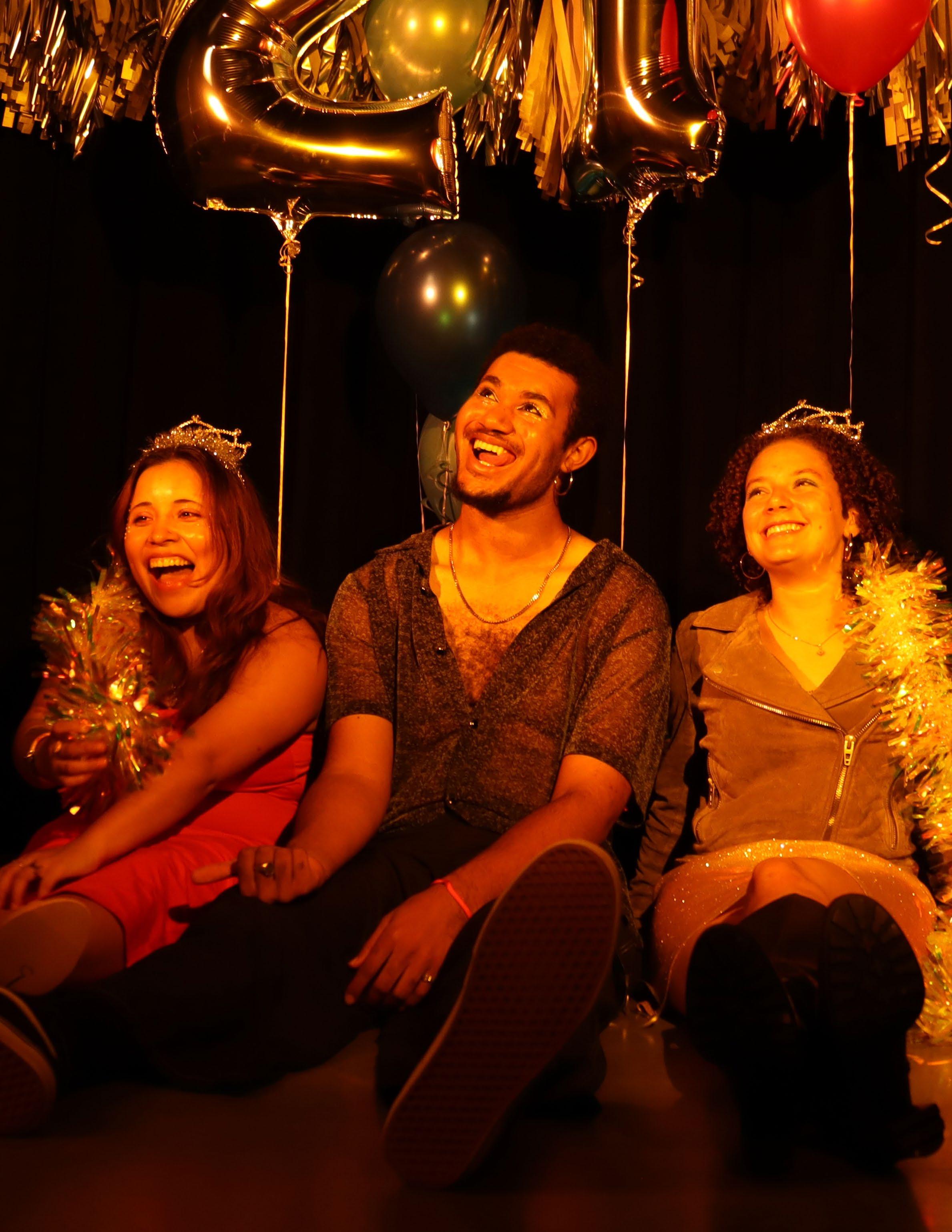
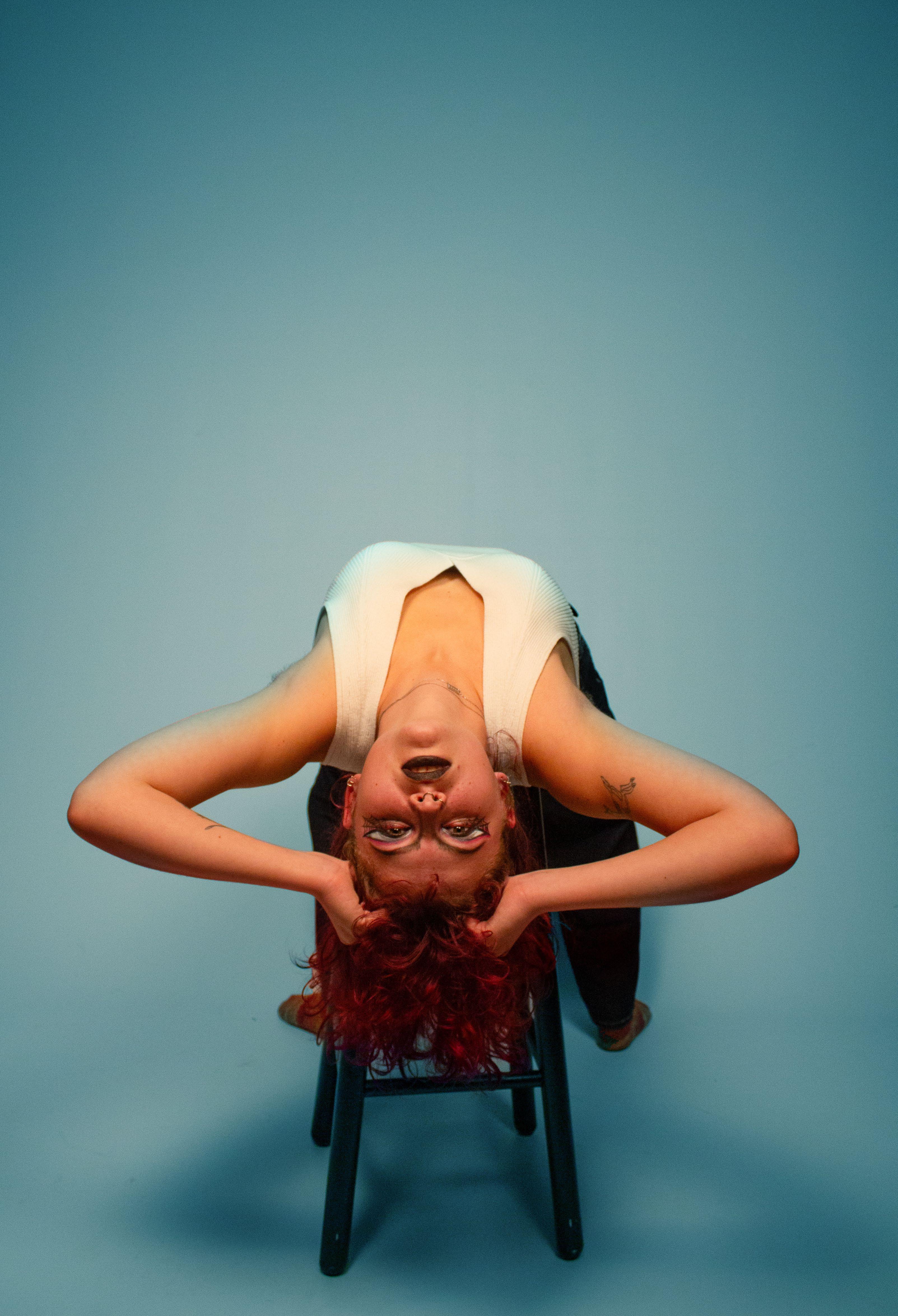

One of the golden rules of aesthetics is “less is more,” but is this always true?
The rise of the “clean girl” and “‘no makeup’ makeup” trends champion a more effortless look, and has led to the creation of the term “makeup blindness”—the idea that we may no longer recognize just how much makeup we are actually using. While the phrase began playfully, jokingly highlighting dramatic applications in one’s own makeup, it has since opened the door for unsolicited opinions on what others consider to be “too much” makeup.
This rhetoric perpetuates a common misunderstanding about makeup—that people wear it primarily for the
By Katrina Nelson ’27
approval of others. Whether one applies makeup to cover a blemish or to add fun color, the intentionality of putting on makeup is different for everyone. The judgment around makeup blindness has made people more aware of how they are perceived. The cultural fixation on perfection diminishes the joy and creativity that experimenting with new colors, textures, and patterns can bring. Like clothing or accessories, makeup should be embraced as an extension of our self-expression, and thus, the negativity and self-doubt brought about by the makeup blindness trend is infringing on the sacred space of identity that makeup shares.





Mperspective on makeup, especially with blush. Cloutier admitted that “I find myself looking at it in different lights, wondering, ‘is this too much?’” Cloutier’s makeup embraces a bold, graphic eyeliner which complements the trad goth look—a subgenre of the goth style that fuses punk influences with a dark, romantic flair to create a vintage aesthetic. Though always drawn to trad goth, Cloutier had not previously had the chance to explore it. “Experimentation should be normalized,” Cloutier added. “If I’m happy, why shouldn’t I wear this every day?”
Embracing the glow, Model Steph Andrade ’26 wears ultra-dewy makeup and an unconventional brow shape. Commenting on the idea of “too much,” Andrade remarked that many makeup styles are simply trends, like the bold brows of 2016. Andrade believes that makeup should enhance the user’s happiness, and noted that while she typically prefers a simpler look day-to-day, she loves wearing more makeup for a night out. “The routine of getting ready is what makes it really fun,” Andrade added.


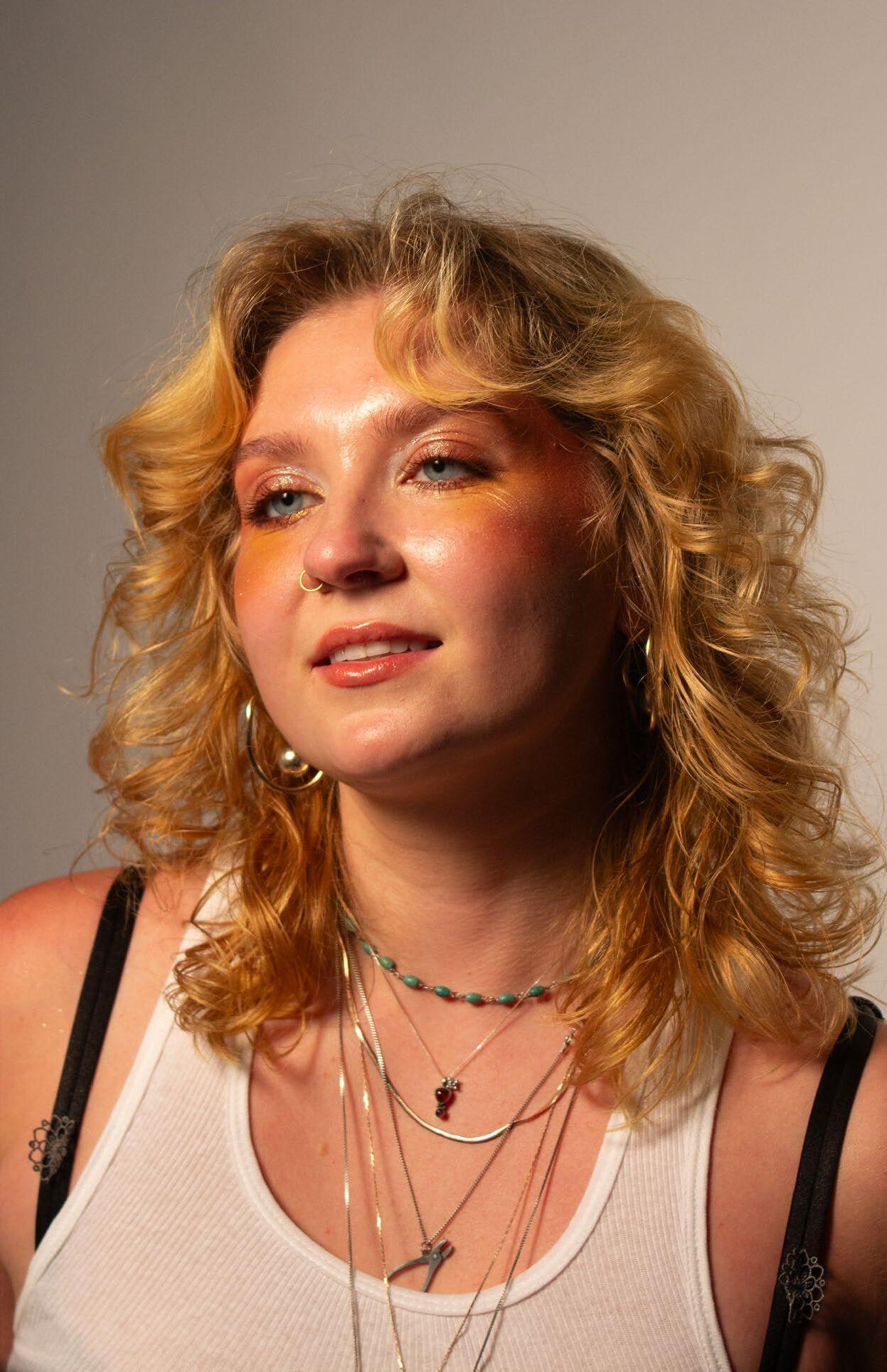
Model Lev Janicki ’27, a less frequent makeup user, showcases a vivid blue winged eye. Although they typically use makeup only on occasion, Janicki expressed excitement over the possibilities of makeup maximalism. “I barely touch natural makeup because, to me, it’s about having fun with my own face,”
they explained. “When I wear makeup, I don’t want to be an unrealistic version of myself; I want to be someone totally different for a little while.”
Inspired by a warm sunset palette, model Christina Stoll ’25 uses glitter to create an ethereal glow. Challenging conventional makeup norms, Stoll reflects on what she
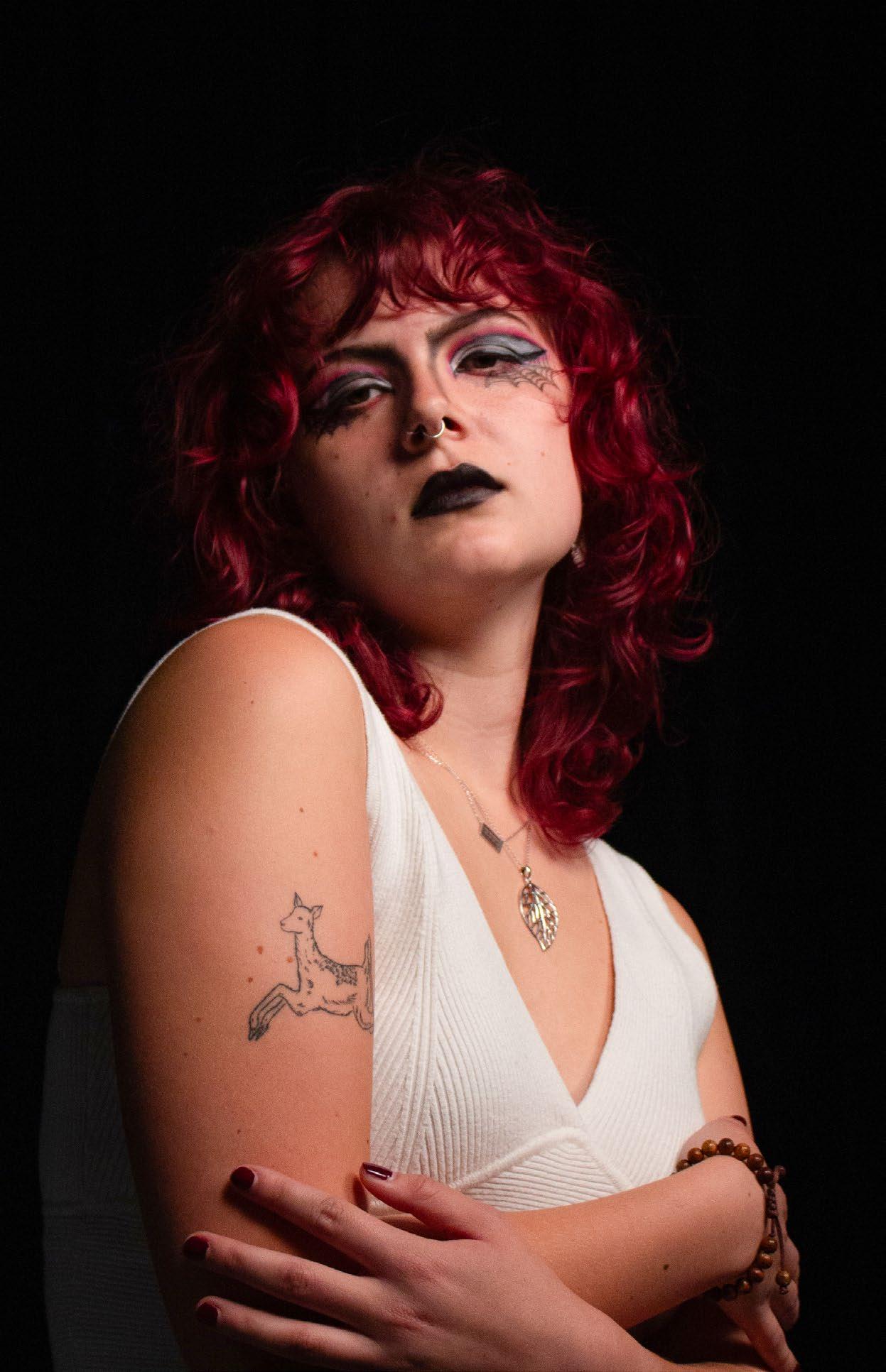
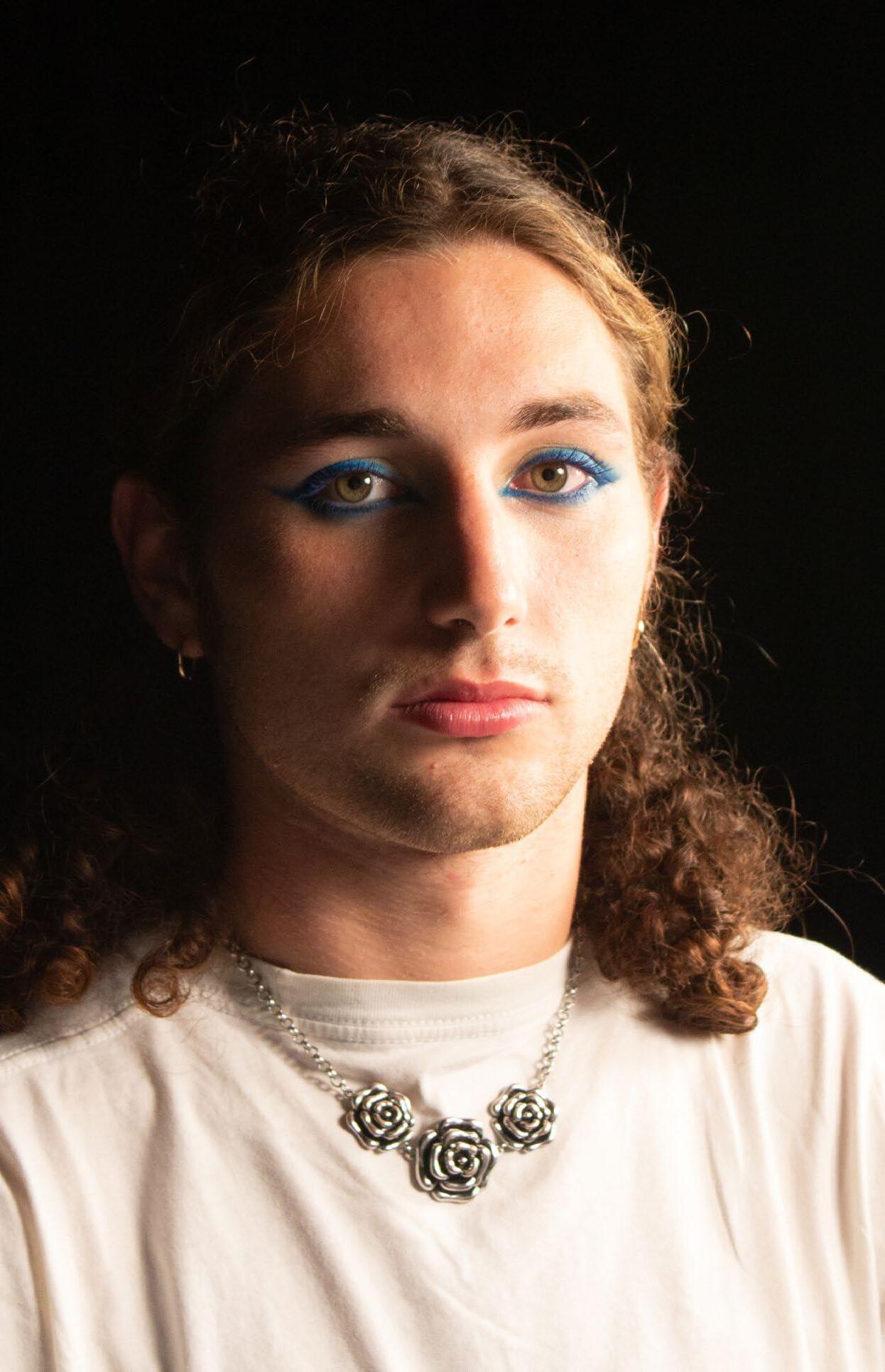
sees as the evolving relationship with beauty throughout one’s life, observing that one’s makeup will change with their personalities as they grow and societal trends change on a larger scale. While some eras may celebrate bold and maximalist looks, others times more minimalist style, allowing for a dynamic expression of our individuality.
The makeup that one chooses to wear because they want to will make them the happiest because they remain true to their identity. Whether we are reaching for concealer or for sparkly eyeshadow, we should embrace the choices that make us feel like our most confident and authentic selves.
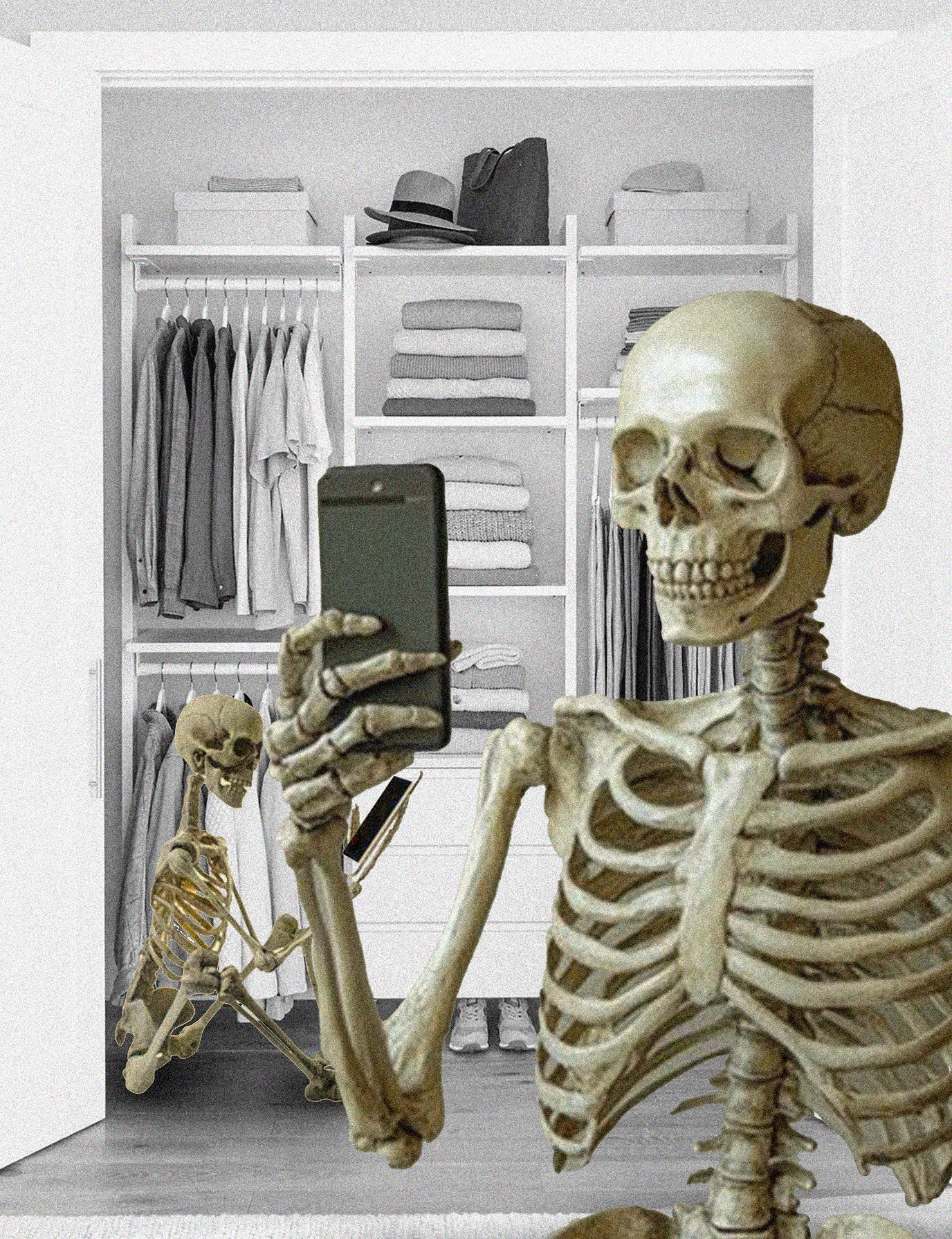




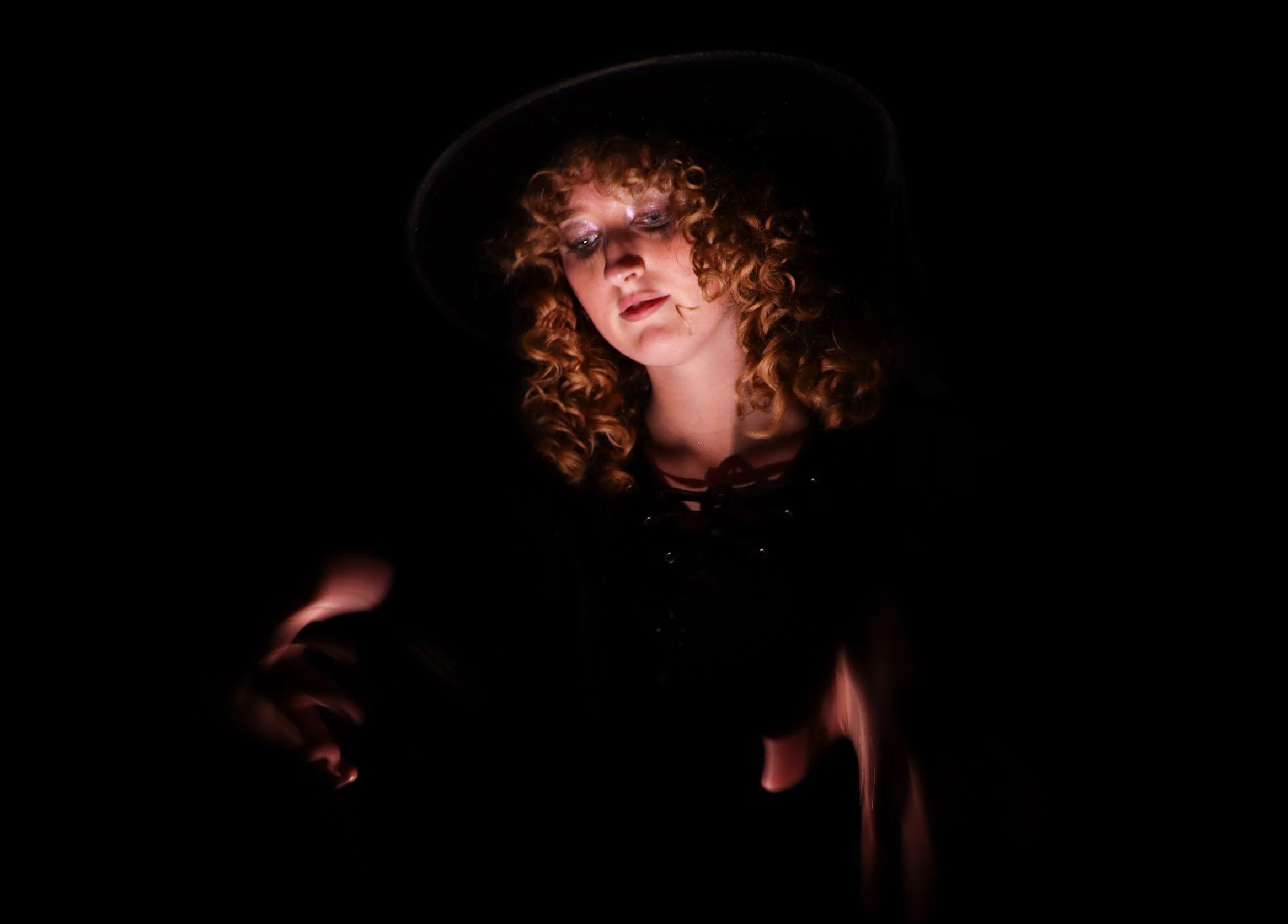
Avestige of its pre-Christian Celtic roots, Halloween sees millions of people of all ages donning costumes which incorporate elements meant to evoke death, the occult, or anything dark, shadowy, or gory. Costumes like witches, ghosts, and vampires have become Halloween stalwarts, but so have costumes that imitate archetypal cowboys and pirates. Why? Because what is scary and frightening does not simply encompass that which is eidolic—our morbid curiosity extends to what is the other. Cowboys and pirates are inherently subversive, otherwise traditional occupations made illicit and nonconformist,


operating on the fringes of society. And this is not arbitrary—what we perceive as scary is often a subversion. So many costumes follow a common pattern: bloody [blank], vampire [blank], dead [blank]. Every year, school girl skirts get splattered with fake blood and wedding veils are tattered; we are fascinated and frightened by what appears to exist in the absence between what we know and what we do not. Perhaps our best proof of the uncanny valley phenomenon is walking into a Spirit Halloween. October 31st is then a time for people to dress in a way that challenges traditional norms, a time when fashion relishes in the taboo.

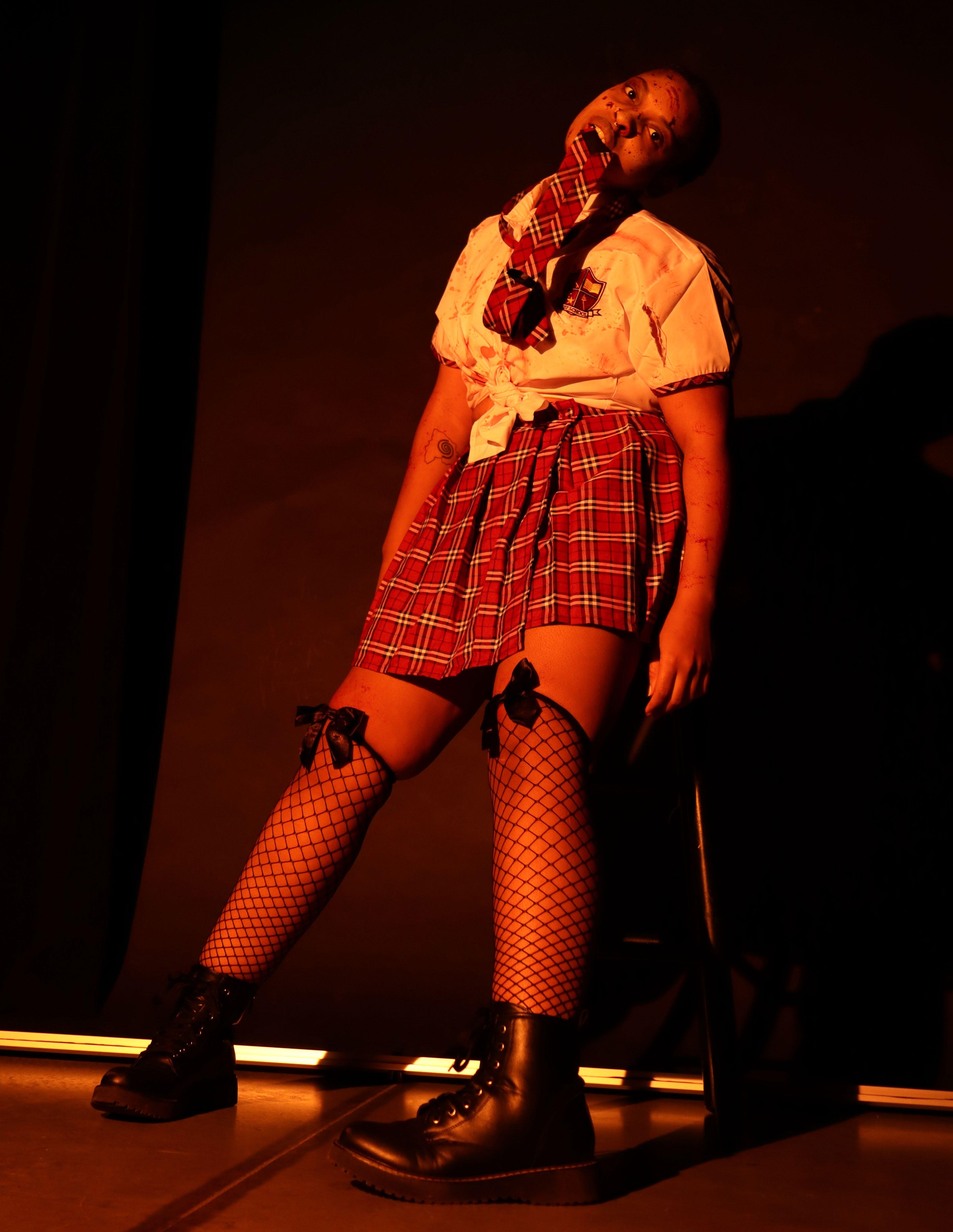

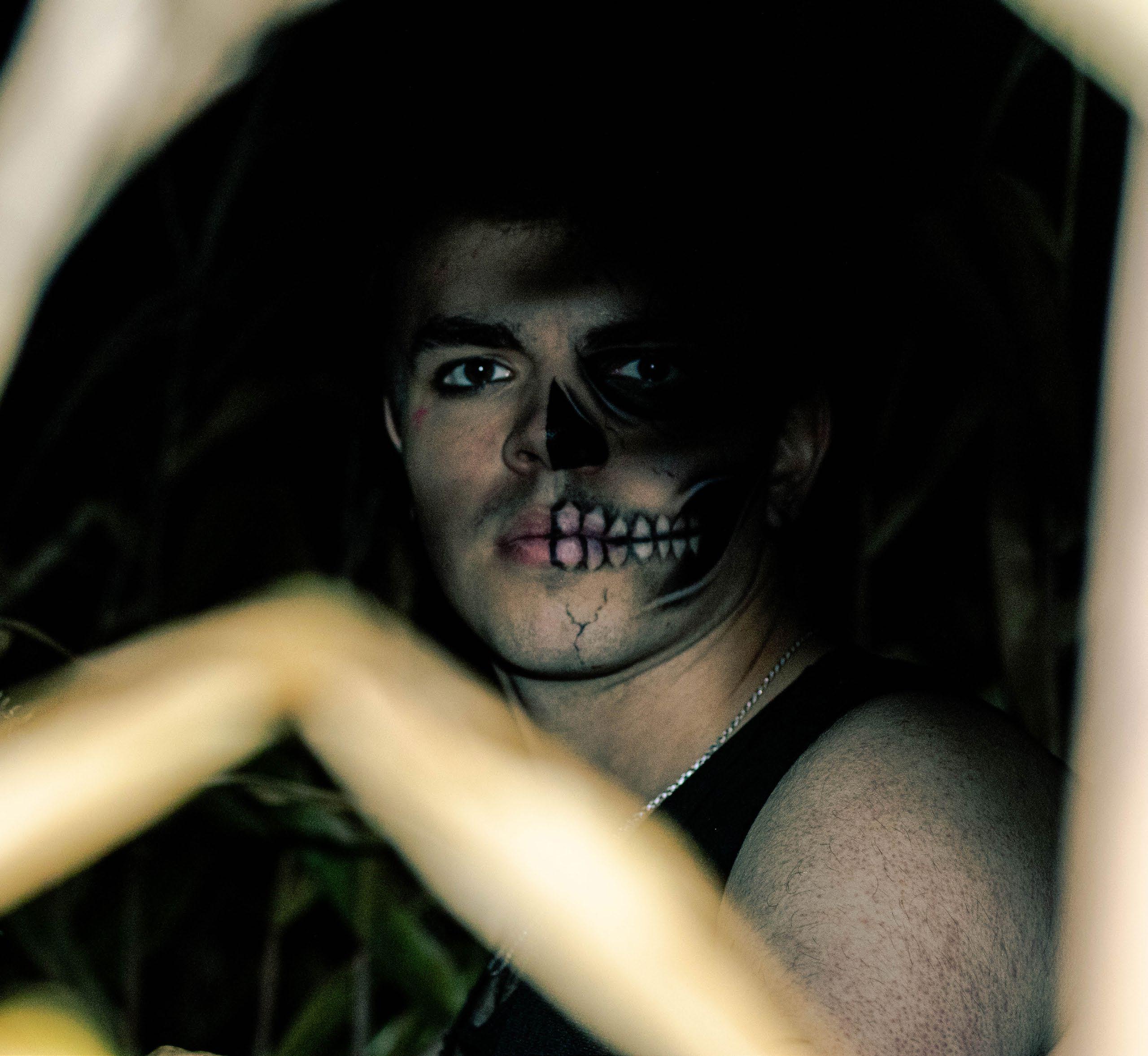
cultural markers denoting grief and respect. These visual symbols of bereavement later influenced goth subculture fashion, characterized by black clothing, silver jewelry, and macabre motifs. At the same time, the spiritualist movement inspired a trend of imitating supposed ghostly beauty, But, why should the skeletons stay in the closet?
They do not necessarily have to. Subcultures have long been places where individuals find space to embrace their fascination with the morbid and subversive year-round, without being confined to a single night of sanctioned terror. Although, of course, the macabre in fashion is not anything new. In the Victorian era, mourning attire was an elaborate ritual. Black lace, heavy velvet, and ornate accessories were not just fashion statements; they were



This shoot celebrates the range of costumes people don on the night of the 31st. Some people adopt the stereotypical intention to show more skin, along with the inclination and tendency to add “sexy” to the beginning of one’s costume choice. The desire to be attractive is not inherently contradictory with the want to be or express the unconventional. As Head Stylist Ella Strasser ’26 remarked at the shoot, “Goth people are hot.” Others are perhaps embarrassed to try too hard or show that they care, and opt out altogether or try for something incredibly basic. When model Jayden Fedorov ’25 was asked whether they will ever try to dress spookily again, they replied that “this is a one time fun thing.”


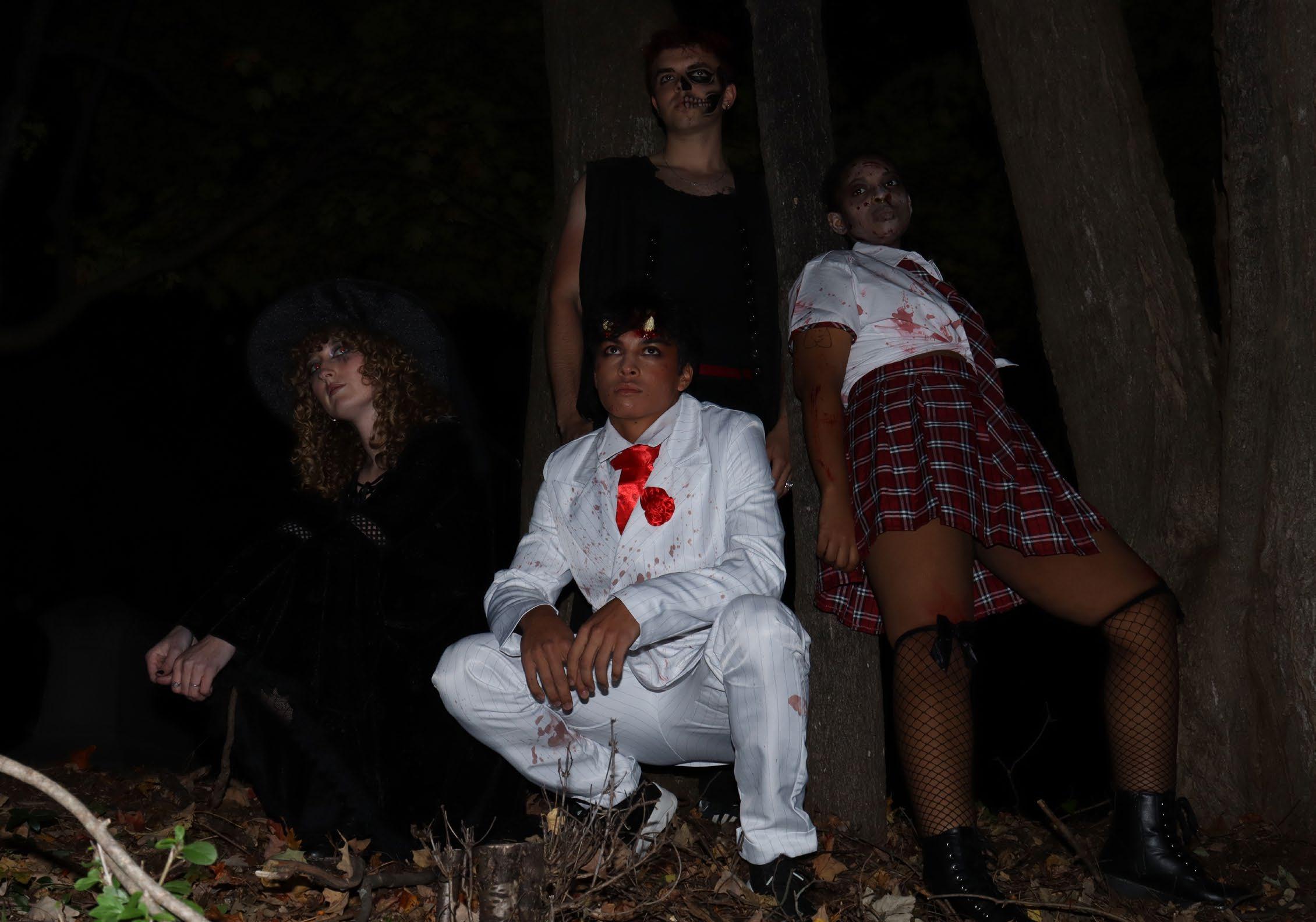
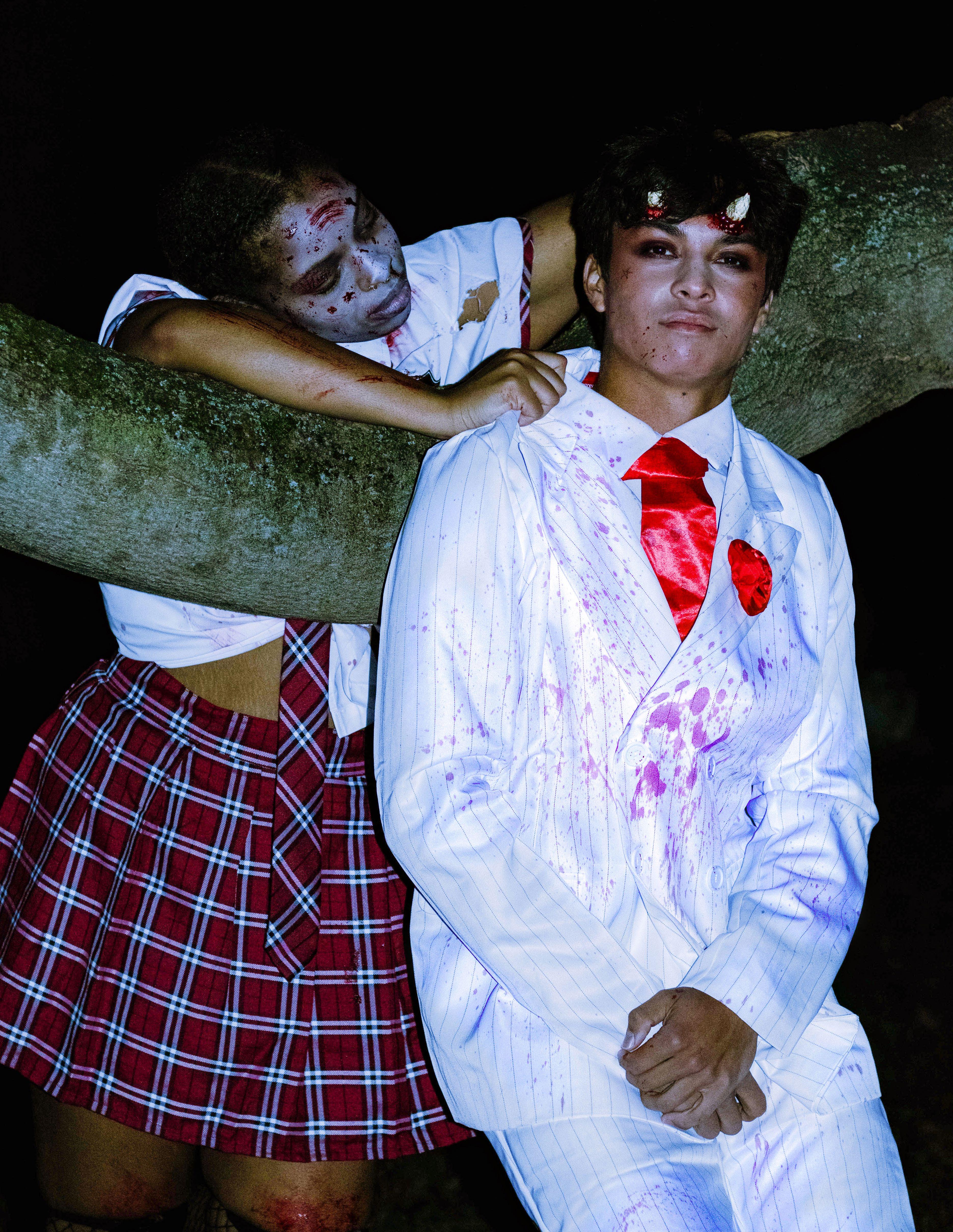


Beauty Director Abby Lowder ’25 remarks that there is a difference between makeup and fashion. While incorporating spooky elements into fashion is reasonable for everyday, often the makeup we do for Halloween is not. Imagine the looks you would receive if you showed up to your 9:00 AM course with fake blood dripping down your cheeks. In all of its liberal arts glory, Hamilton embraces diversity in fashion and self-expression as college students explore their identities, but there is a proverbial line between identity exploration and eerie symbolism.



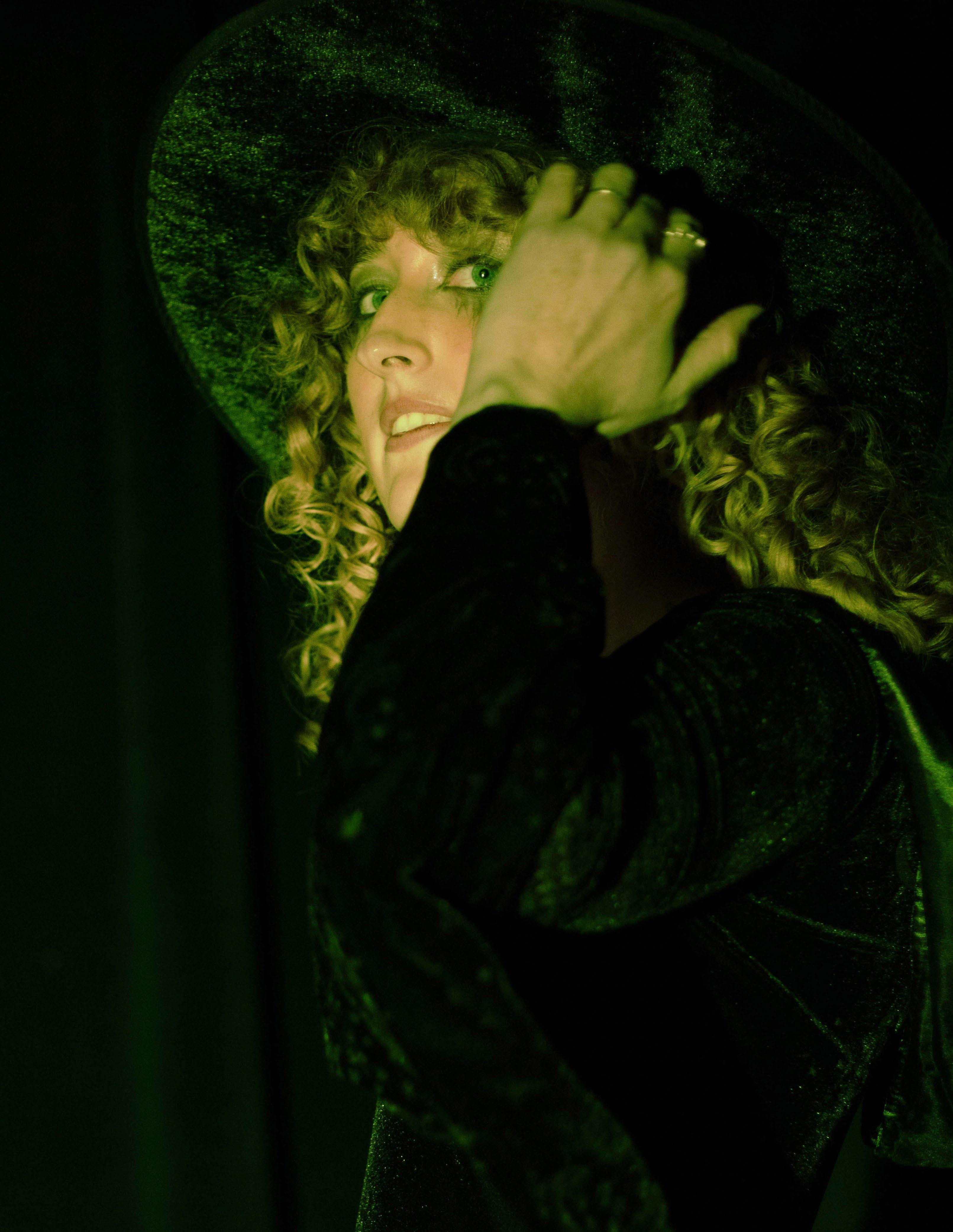

Halloween is a time for anyone to experiment beyond accepted norms with the way they dress. “I think Halloween is an opportunity to try things out, put a mask on, put a character on. And I think that’s what it has turned into,” Lowder said. For anyone who is not fully immersed in a subculture, Halloween is an accessible way to experiment without consequences—to put on a character and see if it feels true.
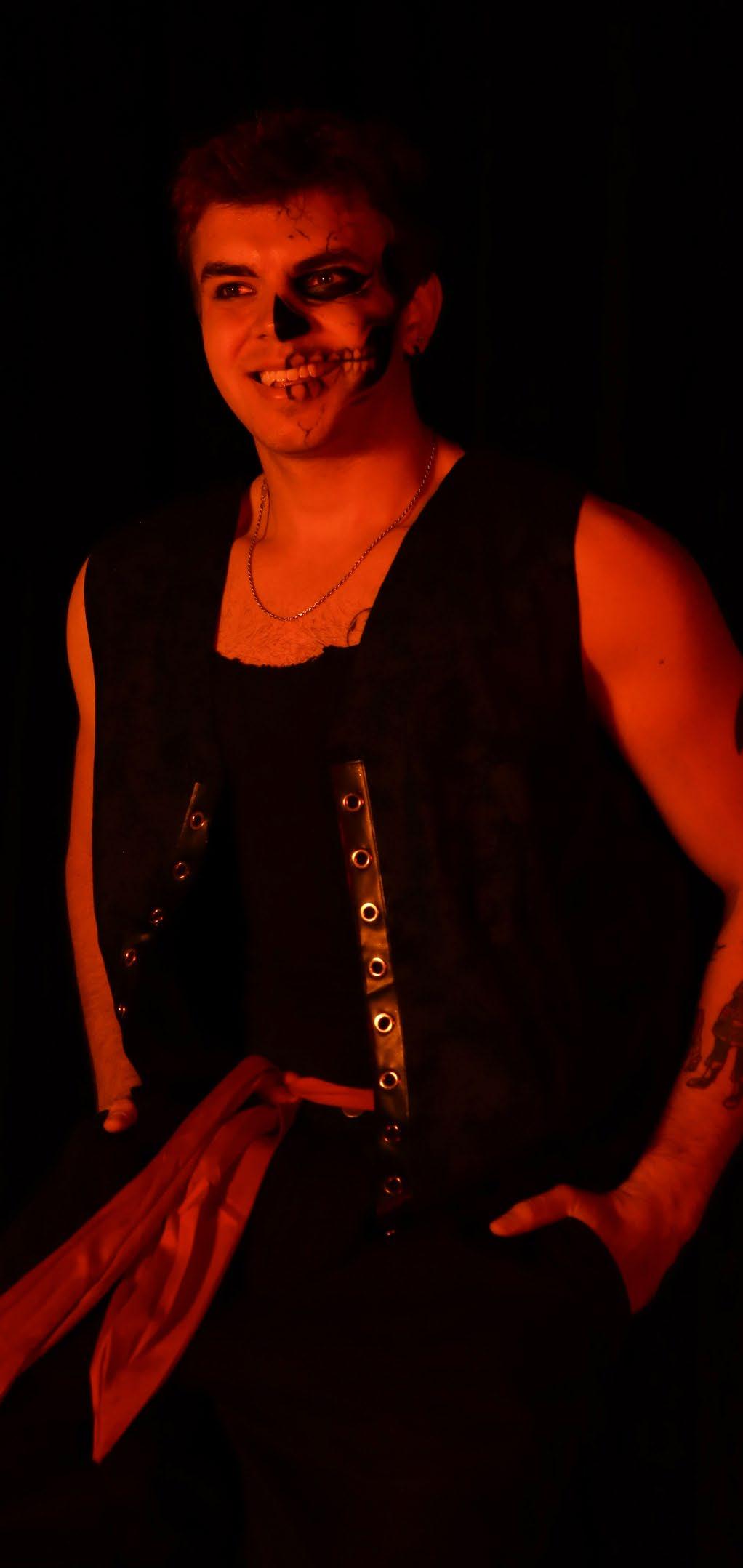
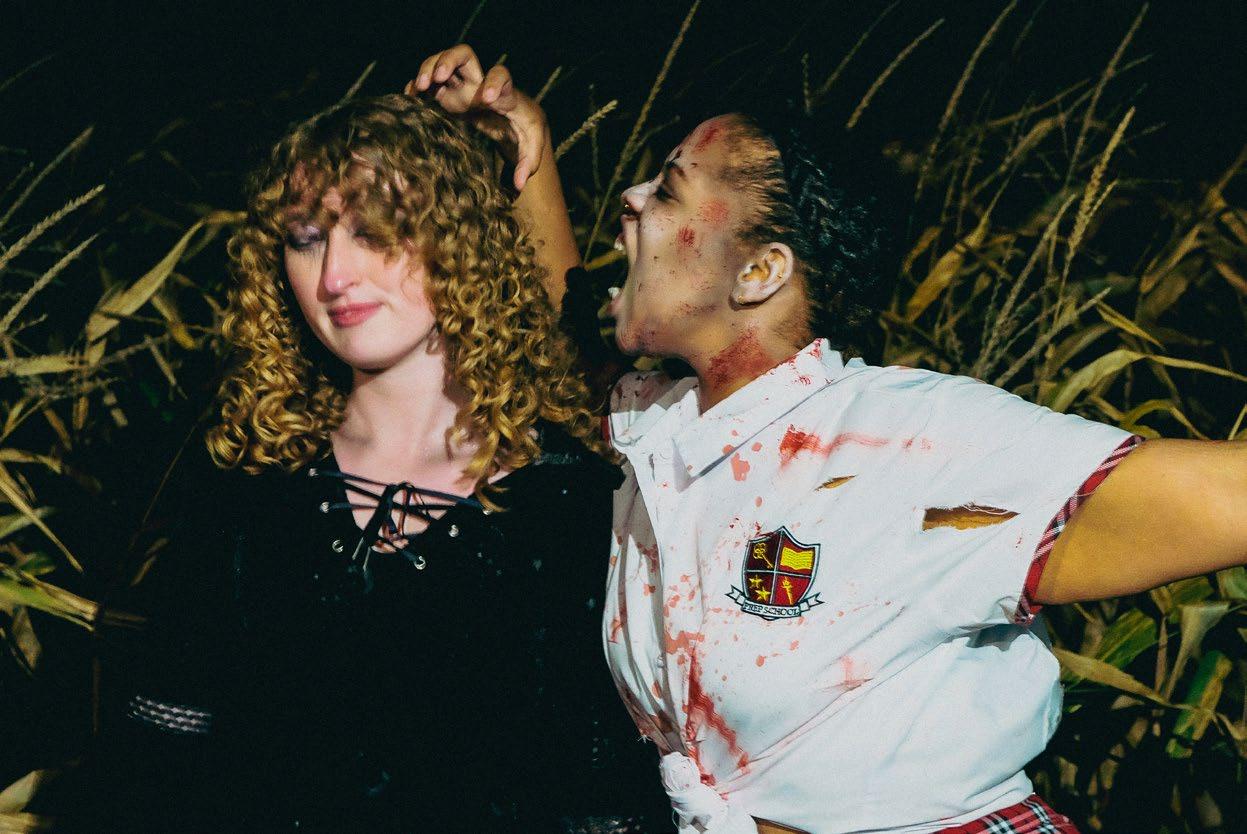

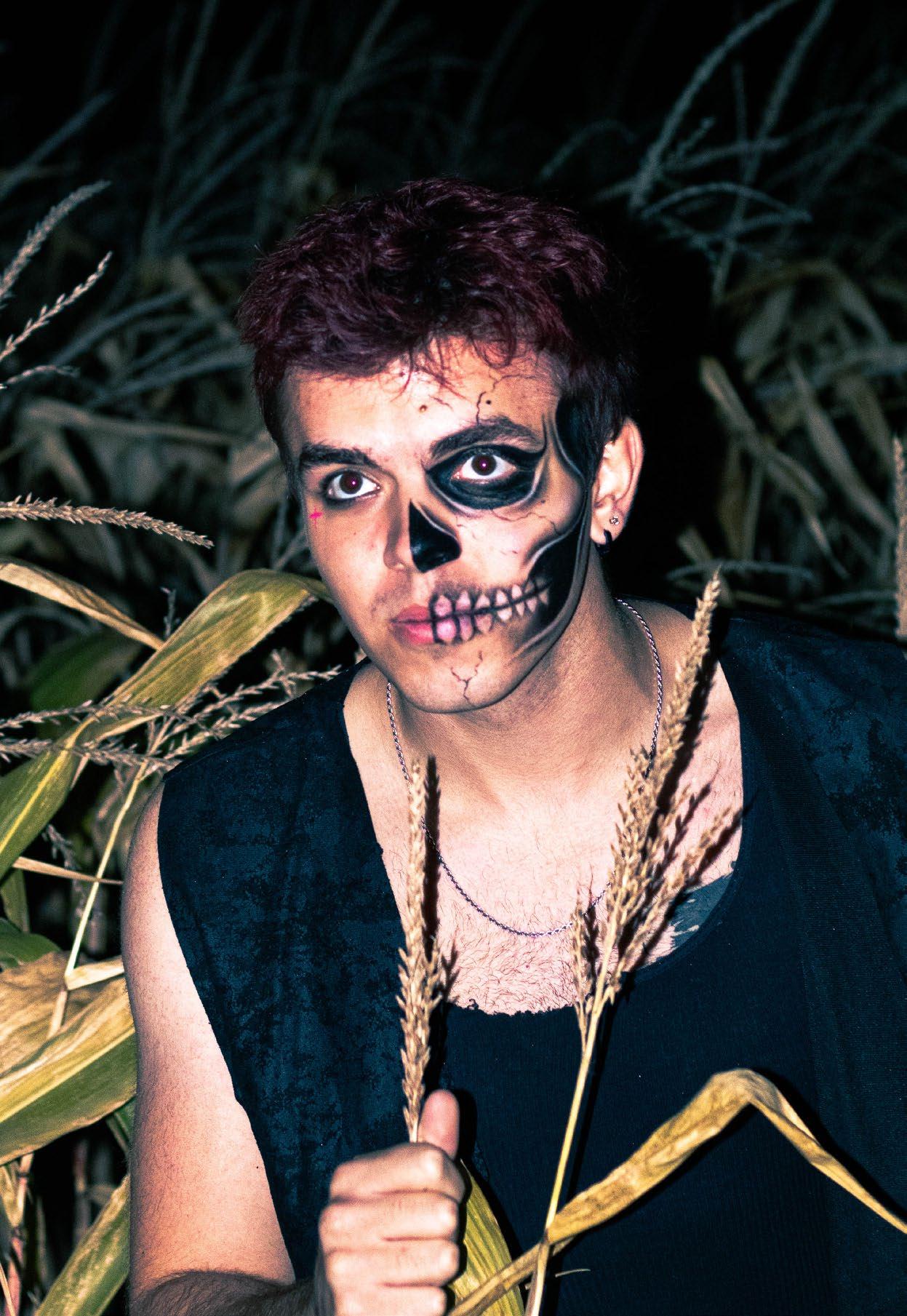

leadership experience with him, but also a signature style that serves as an extension of his personality and values. With a love for bow ties and a thoughtful approach to fashion, Tepper’s style is more than aesthetics—it reflects his identity and the messages he wishes to convey in his role as a leader in academia.
Tepper’s journey with bow ties began unexpectedly thanks to his wife, Dana. “When

Style. What started as a thoughtful gift soon transformed into a defining aspect of his personal style. The bow tie, for Tepper, became more than just an accessory—it was a way to blend different aspects of his personal and professional identities.
“The tie allowed me to engage with the creative industry when I was working with music in Nashville,” Tepper said. And now, bowties are a key component of his identity
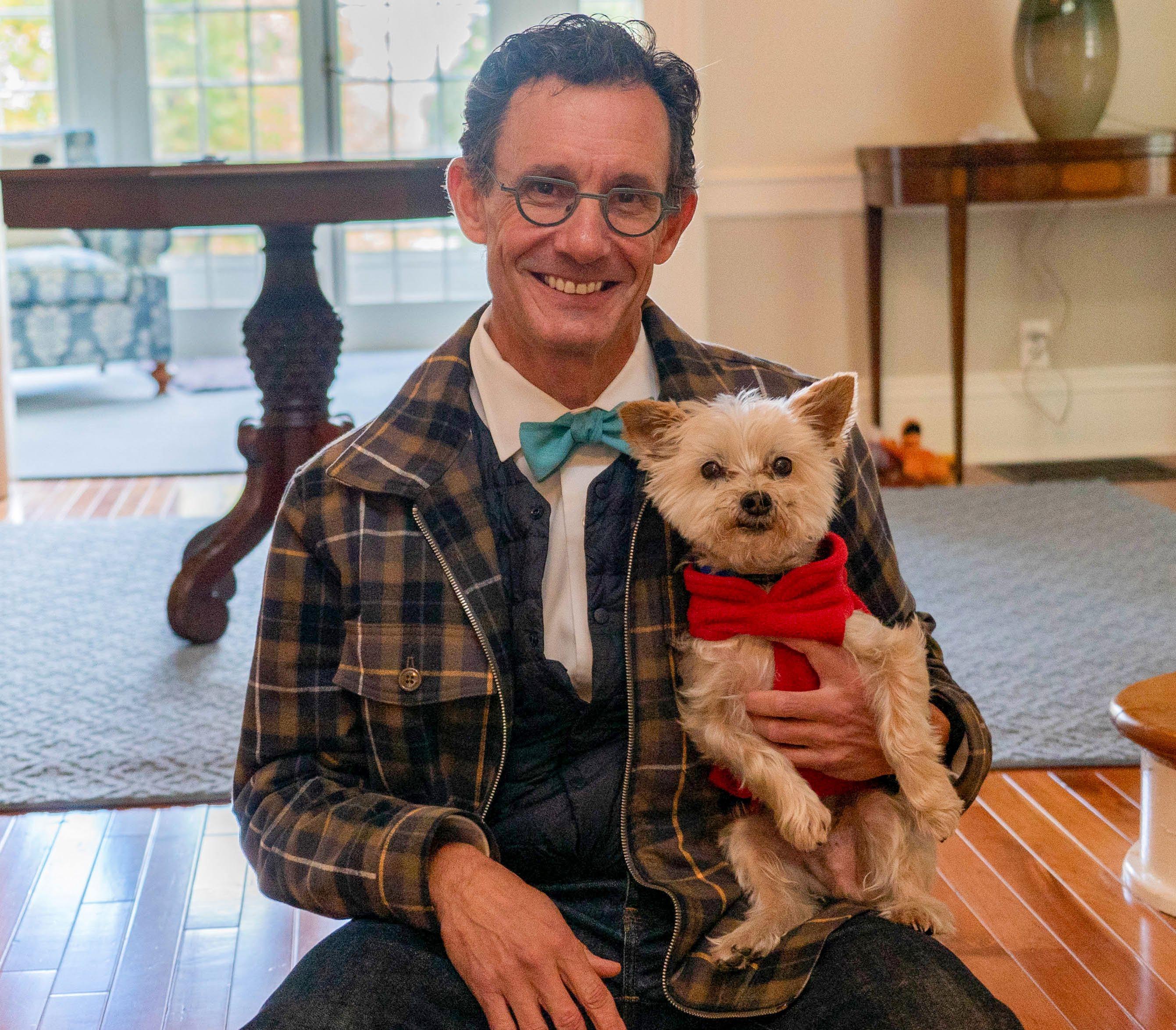
at Hamilton. Tepper reflected that he “grew to like ties because they are a craft. A lot of them are handmade. Tying a tie is a skill; they always look different. Sometimes they are tilted or the shape is different.” This appreciation for craftsmanship parallels Tepper’s broader philosophy about fashion: style is not just about what you wear but about how you wear it, how clothing is made, and the stories embedded within each article of clothing. Tepper’s careful commitment to putting together outfits allows him to communicate his personality and readiness for any occasion with thoughtful, creative choices.
The bow tie itself holds symbolic value for Tepper. It’s not just a stylistic choice; it’s a signal of purpose and energy. “For me, the bow tie itself is a ‘get up and let’s start working.’ When I put it on, I’m ready to get to work,” Tepper remarked. “It signals energy and enthusiasm, which are parts of my personality.” But besides signaling readiness, the bow tie also serves as a form of communication: it is a language of its own in the world of fashion. Tepper, who has taught
sociology courses on fashion and identity, understands the power of clothing as a way to navigate and blend different aspects of oneself. “In academia, you have to get the fashion code right. I think fashion is an incredible vehicle for expressing identities that might be in conflict,” he said. Whether dressing up or dressing down, Tepper uses fashion to bridge his personal and professional worlds—balancing formality with approachability.
One of the more classic examples of this balance is Tepper’s pairing of jeans with a bowtie. “Jeans are not quite right for the president, but jeans with the bow tie suggests that I’m ready to get to work and I’m honoring the office,” he explained. This blending of casual and formal elements in his wardrobe reflects Tepper’s ability to communicate across different contexts. His style acknowledges the gravity of his role while also making a statement about his leadership style: approachable, modern, and in tune with the Hamilton community.

Tepper’s wardrobe is rich with personal stories and connections. His bow ties, in particular, often carry sentimental value or reflect specific moments in his life. One example is a bow tie featuring meerkats, a nod to his children, whom he affectionately calls “meerkat one and two” because of their past teenage tendency to stay in their rooms like meerkats in their burrows. “When I left my last job, I wrote a story about our community, a fairytale where I was a meerkat who was brought out of my den to be shown the incredible forest. So my colleague bought me this tie with the meerkats,” he shared. This blend of family and professional connections reflects how Tepper’s fashion choices are deeply personal, often serving as tokens of relationships and experiences. For Tepper, what may seem simple has a deeper meaning.
Another significant bow tie in his collection is one he had custom-made for his first presentation to the College’s campus last February. He purchased a Hamilton tie and commissioned a seamstress to turn it into a bow tie. This custom-made bow tie indicates Tepper’s instant dedication to Hamilton, marking his introduction to the college and reinforcing his commitment to engaging
with the community through personal expression. Now, a few months into his position, it is a pleasant reminder of Tepper’s desire to integrate personal style with institutional pride from the get-go.
Tepper’s fashion philosophy isn’t only about bow ties. His approach to style reflects a broader ethos of experimentation and playfulness. “I’m into happenstance. I like sometimes wearing plaid with plaid, or pairing colors that don’t quite match,” he said, revealing his willingness to take risks and embrace the unexpected. For Tepper, fashion is about finding the courage to push boundaries and embrace one’s unique expression. “With fashion, when you get right up to the edge of ‘I’m not sure I can do it,’ and then you do it and wear it confidently, it becomes your favorite thing. But you have to have the courage to do that. So I have a courage tie; one that when I got it, I thought I would never wear.”

This commitment to courage and playfulness is also evident in Tepper’s attention to detail, whether it’s a pair of Hamilton 1812 cufflinks gifted by a trustee or a well-worn pair of Allen Edmonds shoes with an important story. “My brother was a banker in London, so he had a nice wardrobe. I was working my first job out of college, so I did not have a nice wardrobe. We were shopping because he had to buy himself a nice pair of Allen Edmonds shoes. He asked, ‘Do you need shoes?’ and I said, ‘Maybe? I don’t know; I have my whole future ahead of me!’ And so he bought me my first pair of dress shoes. Now, 35 years later, they are a little worn down, but they’ve been resurfaced and resoled many times.”
Ultimately, Tepper’s style is about storytelling. “Think about what story you are telling. Do you like to buy clothing that has an origin story? Do you want to know where your clothing is made? Do you like having a relationship with the material? Play with the grammar of fashion and pay attention to all of its codes. It’s important to own it, find your story, and make it a part of your daily expression.”
For President Tepper, fashion isn’t just about looking good—it’s about crafting a story, engaging with history, and embracing the tales behind every stitch and every tie. While bow ties may be his signature piece, his style is ultimately a
reflection of his broader philosophy: fashion is a craft, a conversation, and, above all, an expression of identity.
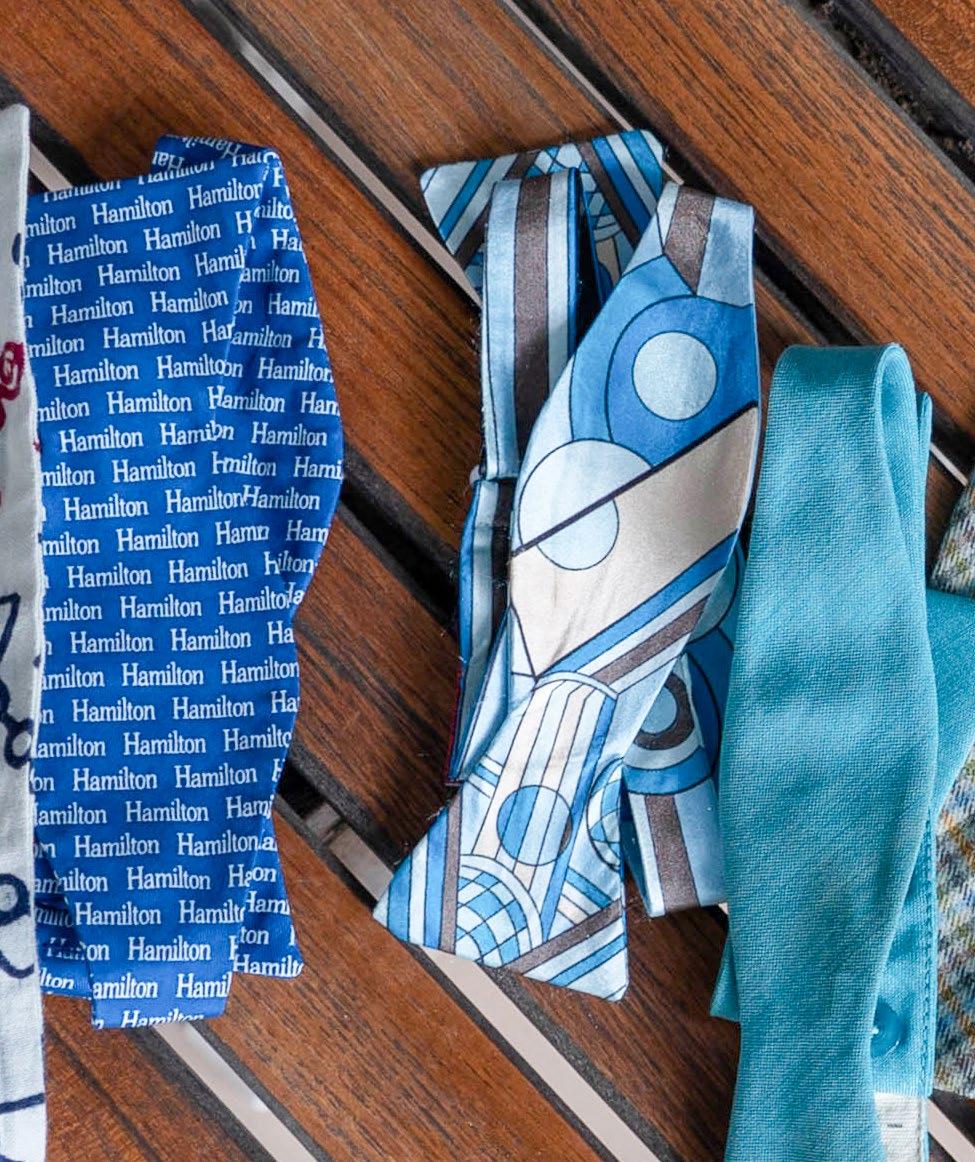
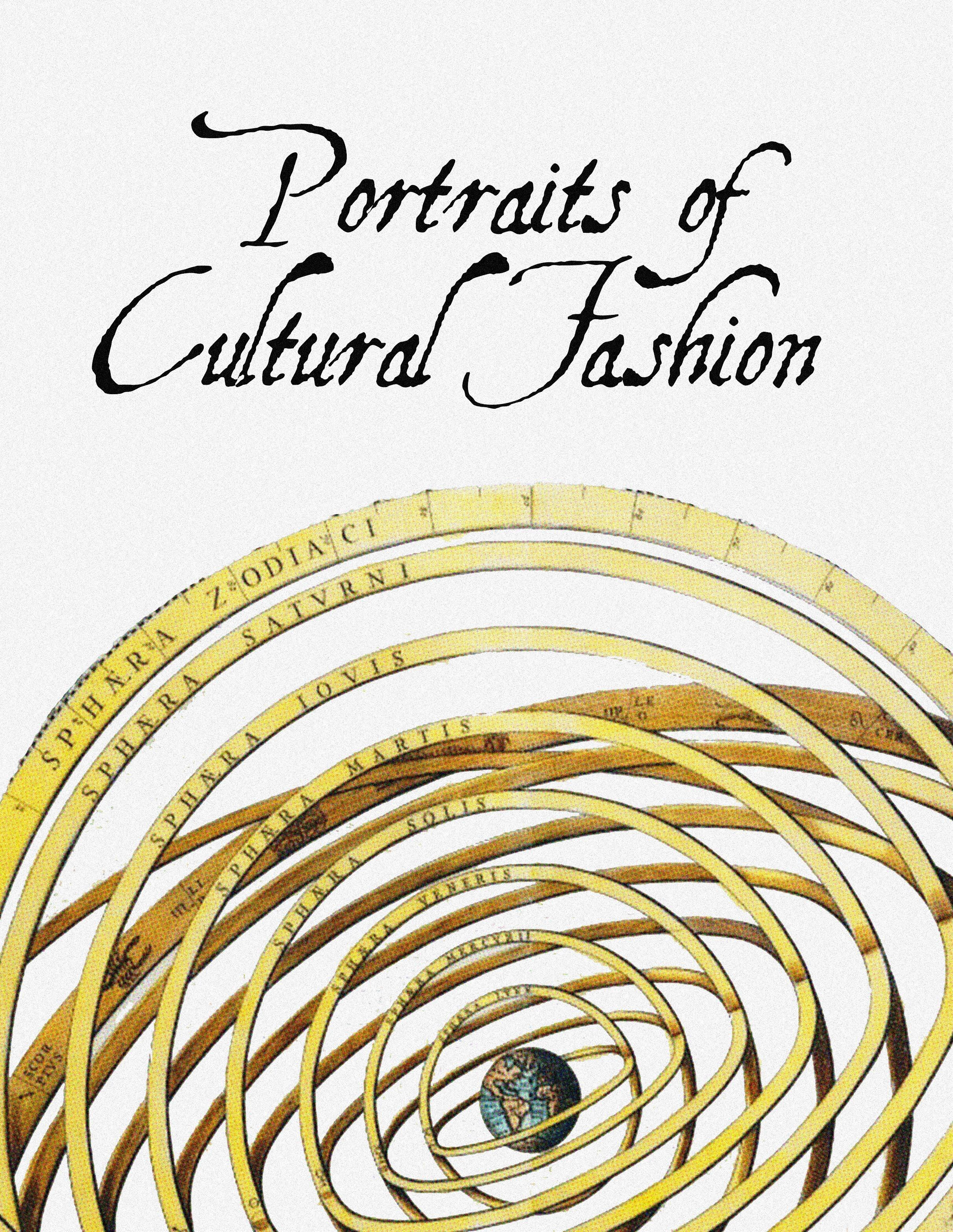
students hail from 56 countries and all 50 states. Yet, despite the geographical diversity, life on the hill can feel incredibly insulated. Using style as a means to reconnect with family, culture, and birthplace is a common practice amongst students who hold pride in their cultural heritage.
Eric Li ’25 first chose to showcase a tai chi outfit made from silk. As Eric was born in Canada, he often feels a disconnect between his Chinese background and Canadian Westernization. As Li noted, a person can be born in a place, but heritage can lie somewhere else. To balance these dual identities, Li expresses himself through wearing clothing that emulates his parents’ traditional style. For example, Li’s father practices tai chi every morning, so the silk shirt is reminiscent of the attire he would wear to practice. The red of the shirt also holds meaning, as Li noted that he wanted to represent the national colors of his home country of Canada to blend birthplace with heritage. Similarly, Cooper Xu ’25 wore a Tangzhuang, which is a style of clothing that has become a representative of Chinese traditional culture, often worn in many occasions such as weddings, holidays, lunar new year, formal events, and more. Cooper was born in the United States but grew up in China, so was surrounded by people with his same culture. However, upon entering Hamilton, Xu was introduced to an environment where he was one of only a few Chinese students. At Hamilton, Xu developed a renewed pride in his heritage, specifically for China’s 5,000 years of unbroken history. Having never been conquered by another nation and undergone many dynasties, the nation has developed a rich and diverse culture based on learnings, values, and traditions passed down through generations.


The passage of clothing through generations is a way to connect with family. Helen
Bradfield ’28 paid homage to her Irish background through her outfit, featuring a cashmere sweater that was in her grandfather’s possession for over fifty years. The forest green of the sweater is reminiscent of Saint Patrick’s Day, which Helen’s family celebrates by making soda bread together. Helen is also wearing symbolic jewelry, such as a necklace she bought in Kerry, Ireland, as well as a claddagh ring from her mother.
Cathy Carlson ’26 wore cultural attire that also holds a personal connection, as she donned a yukata borrowed from her ‘sensei’, Visiting Instructor in East Asian Languages and Literature Haruka Higa. Cathy went to a culturally diverse middle school in Los Angeles, where she was able to celebrate her Japanese heritage through attending international food festivals. Additionally, Cathy attended Obon festivals and tea ceremonies in which she wore her own yukata, which is adorned with a design of illustrated geishas. The garment is traditionally worn in the summertime, as it is made from a lighter fabric than a kimono, and features vibrant patterns such as florals and geometric shapes. The wraparound belt on the yukata is known as an ‘obi’, and forms a bow at the back of the garment.
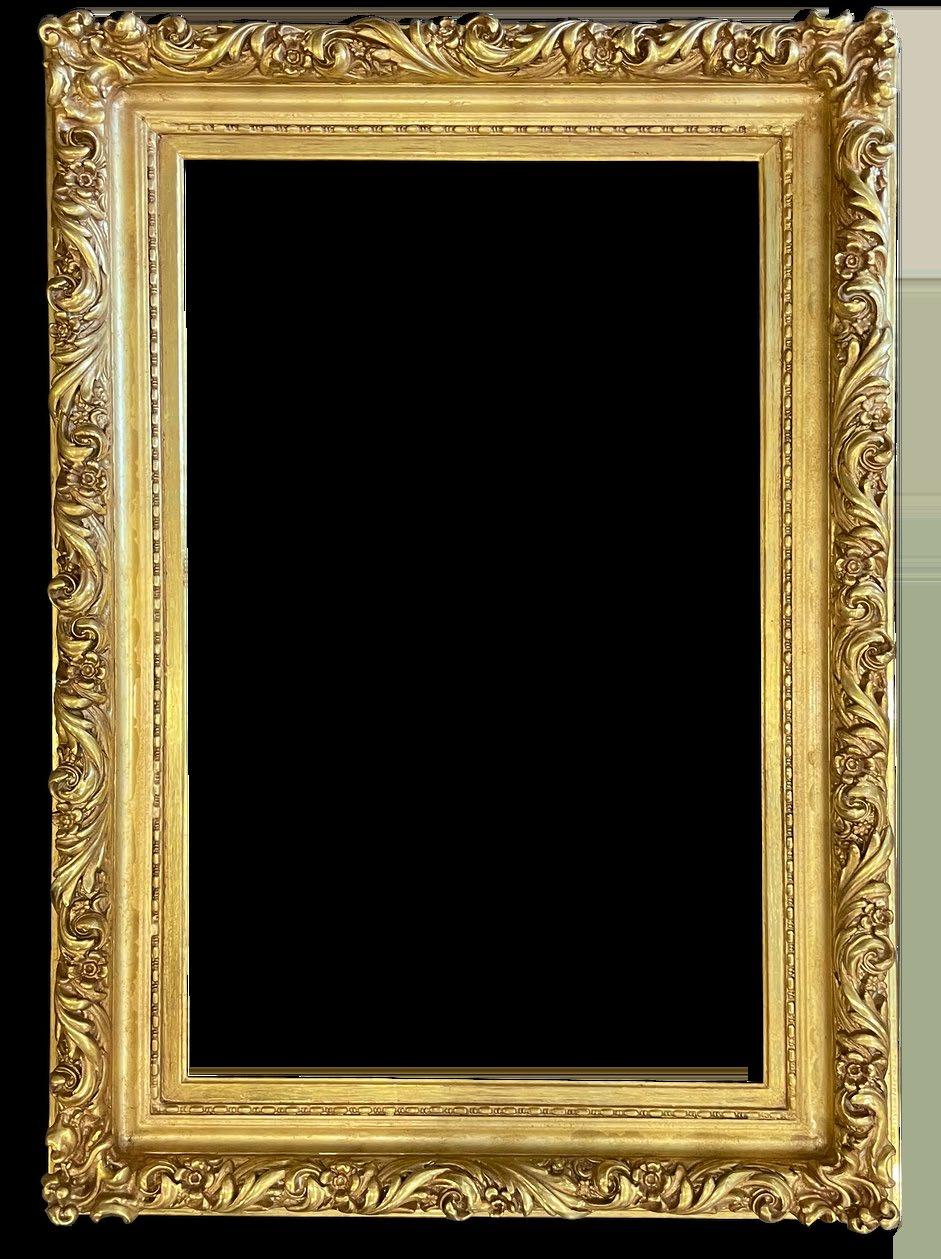

Taima Ashour ’28 featured a traditional outfit from Tripoli, Libya, called a Rdey. Depending on the event and the city, the components of the garment changes, but Ashour’s is a baby pink with real embroidered silver. Jewelry is heavily featured as well, with Ashour wearing gold bangles and necklaces. Usually, a full body gold wrap would be layered on the garment, but its heaviness limits practicality. The outfit is used for special occasions, such as for a bride on her wedding day. Ashour’s Rdey holds a special place in her heart, as it was passed down from her grandmother.
Hpoo Yadi (Kate) ’28 chose to showcase her heritage through formal wear as well, donning a traditional Burmese costume. The garment is made up of removable layers that can be worn together or apart. Yadi often pairs the skirt, called a longyi, and matching blouse with other items in her closet for a more casual look. Additionally, Yadi noted that the outfit is tailored to her, creating a perfect fit. In recent years, designers have been incorporating modern, ‘trendy’ fashion techniques to the costume. For example, Yadi’s blouse features a button that allows the torso to fit higher up on the body.

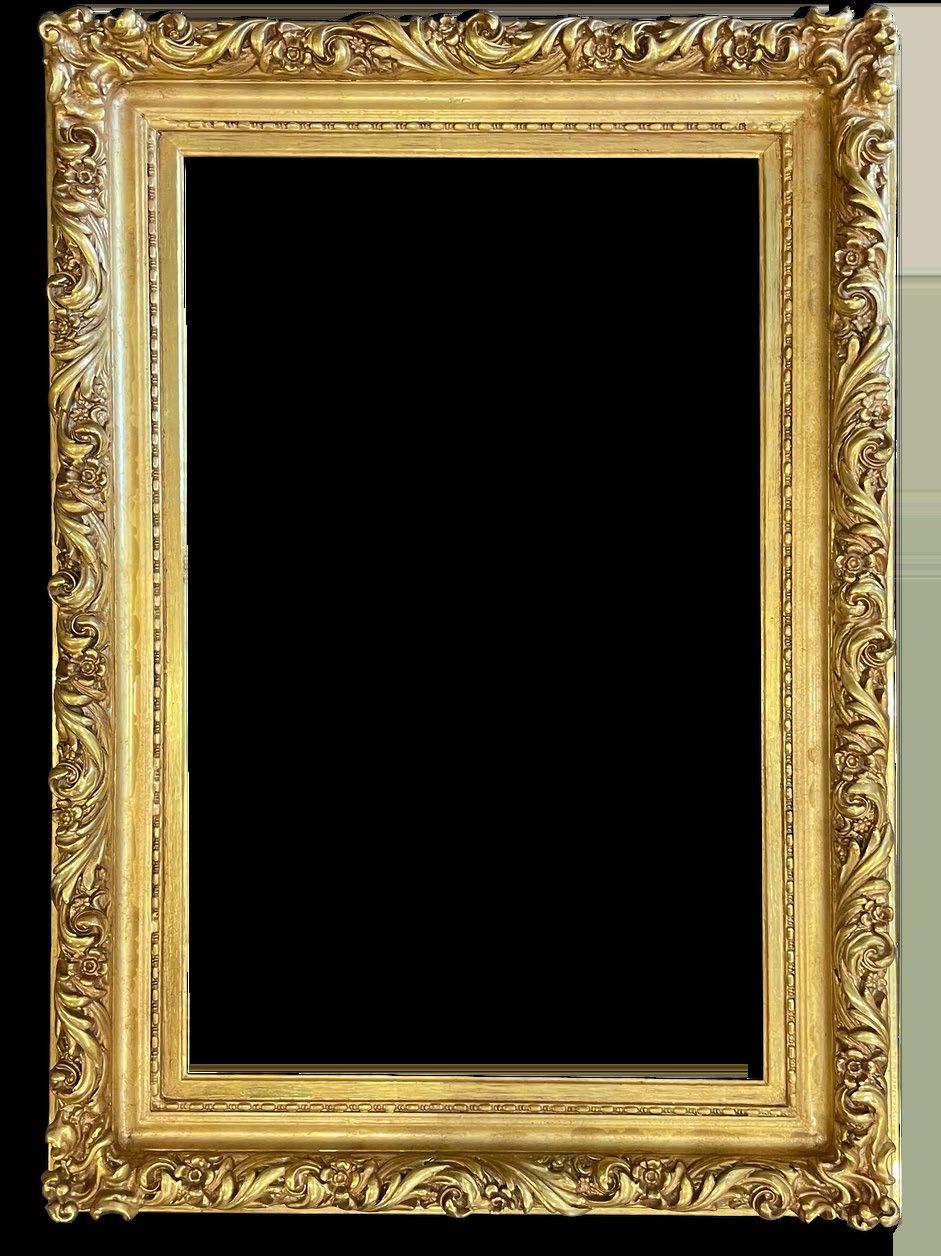
Ilsaa Siddiqui ’28 opted for a casual look to showcase her home city of Karachi, Pakistan. Ilsaa’s shirt, known as a kameez, is packed with intricate details, such as an embroidered flower design with pearls sewn within it, as well as slits on the side. The shirt is traditionally paired with a lighter linen pant, but Ilsaa chose to wear leggings with her kameez. For more formal occasions, shimmering fabric, longer skirts, and gold elements are incorporated into the outfit. Ilsaa also has a nose piercing on her left side. Other incorporated jewelry included bangles, or ‘churi’, and traditional earrings worn in Pakistan, India, and Bangladesh. The hairstyle Ilsaa chose was purposeful as well, as the half-up, half-down style showcased its length. In Pakistani culture, long hair is a desirable feminine trait as it shows the hard work required to maintain it.

Vibrancy is key to Palmer Yongka Yerima ’28’s hat and garment, which features a wide array of color. Yerima is from the northwest region of Cameroon, so he chose to display traditional clothing that would be worn to weddings, chiefdom integrations, and church. Yerima also opted to wear a watch gifted to him from his father, who emphasized time management as part of Palmer’s core values. Yerima’s shoes are also from Cameroon’s neighboring country of Nigeria, and the garment as a whole was specifically tailored for him.
Meraly Morales Tula ’25 wore a layered dress made for her at the age of nine to dance in her hometown of Vera La Cruz, Mexico. The colors featured in the dress are red and white, and it is traditionally paired with white dancing shoes. As Vera La Cruz borders water, the white lace in the dress is meant to mimic sea foam while dancing. The red flower in Tula’s hair is customary as well, as it indicates whether the wearer is married or single depending on which side it is placed on. Dancing was an influential part of Tula’s childhood, and she paid homage to this passion through carrying a candle that is balanced on the head during a routine called “The Witch.”

Atraditional outfit from Greece also has a basis in dance. Maria Ioannou ’26 wore a garment known as a spaleta which originates from Kythera, a small island in Greece, in which Ioannou visited over the past summer. Kythera has a whimsical, free feel to it, as the culture of the island features live music, festivals, and dancing. Each region in Greece has their own unique costumes and dancing style, so in Kythera, the spaleta is made from lighter material due to warmer weather. The velvet sleeves and vest of the costume add a layering effect to the outfit, and heavy jewelry that often depicts gold coins are a staple as well.

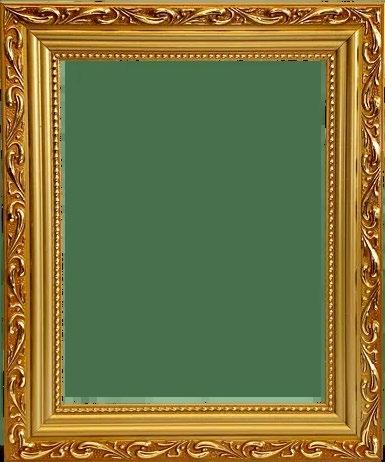
The clothing of Teja Singh ’25 represents his membership to the Sikhism religion.
Spiritual guides and leaders of the Sikh community, known as gurus, spread the message of truth and oneness across India, growing Sikhism from a small community in the Punjab region to a sovereign place. The Sikh courtly aesthetic blends traditional clothing, symbols of beauty, and emblems of the Sikh faith to embody spirituality and the warrior identity. The base of Singh’s outfit is a kurta pajama, which is adorned with a kirpan (knife) and a kara (bracelet). Singh also has a khanda (sword), a symbol of sovereignty, and reflective of the sixth Guru’s message of Miri Piri, which emphasizes both spirituality and physical action. Sikhs believe in a life of action to connect with God. Singh has long hair and a beard, both markers of the
unique Sikh identity that was given to them by their 10th Guru, Guru Gobind Singh. Singh’s turban is a marker of visibility, a call to represent everything that a Sikh stands for. Examples of this transcendent duty can be found throughout Sikh history, one example being the 9th Guru who gave his life to stand up against the oppression of Hindus. Musicality is also a key part of Singh’s religion, as singing devotional poetry was how the Gurus spread their message, and is the medium of devotional worship and expression. Singh grew up singing with his mother and father, and first performed at five years old in a gurdwara (Sikh place of worship). Singh showcased his voice along with the playing of a traditional instrument called a dilruba, meaning ‘heart stealer’, while in his garment.

In showcasing traditional fashion, students highlight more than just their garments –they share stories, memories, and cultural pride. Together, these vibrant expressions allow students to bring pieces of
themselves to campus while creating a community in which everyone can celebrate their own roots and share in one another’s cultures.
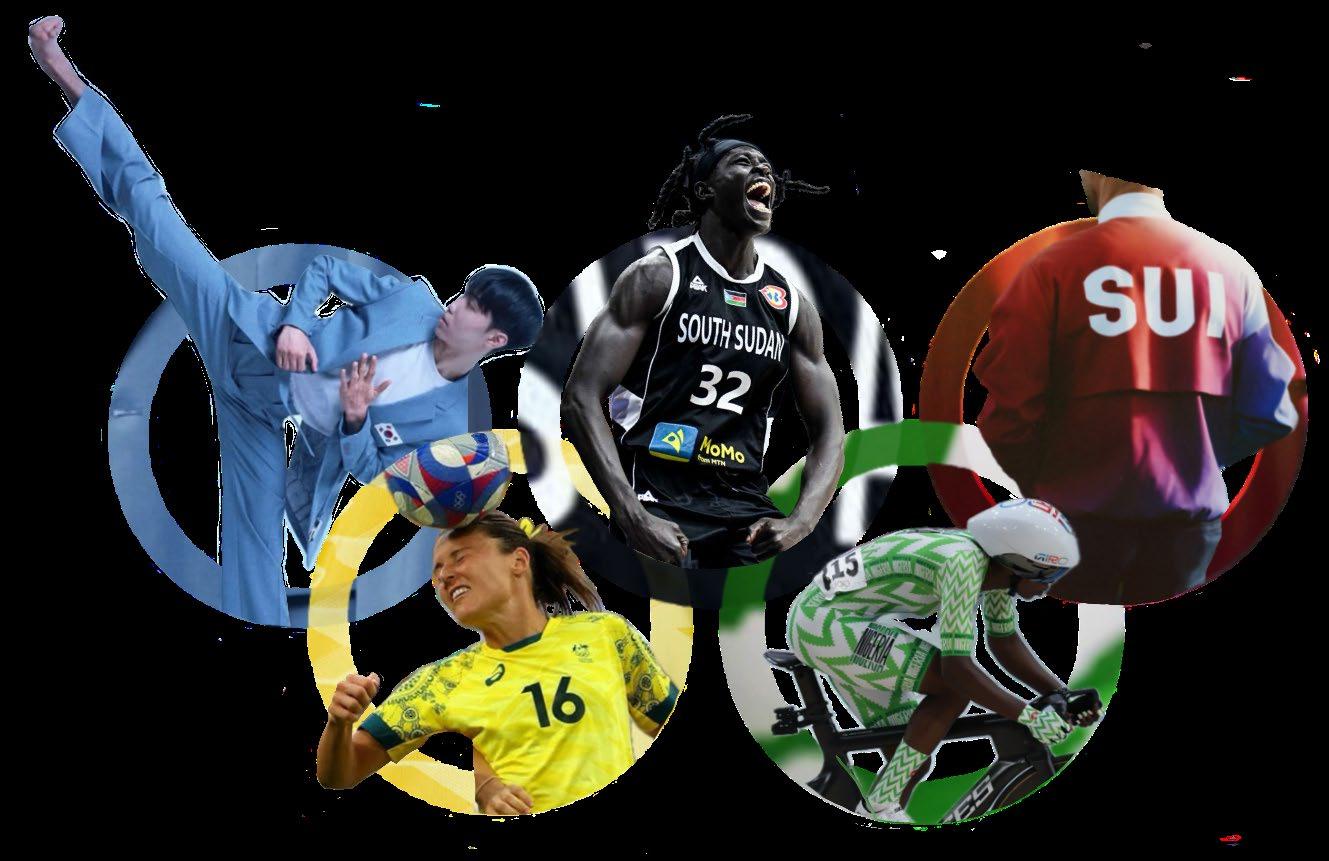
The Summer Olympics present an opportunity for each participating delegation and their athletes to showcase the fruit of their training in order to chase medals across 32 sports. Paris, France hosted the 2024 Summer Olympics, a location synonymous with the world of fashion and a focal point for innovation in the fashion industry. Knowing this, designers of each nation spared no expense in pushing out beautiful uniforms that expressed their cultures and values. The fashion of the 2024 summer games demonstrates that the Olympics is not only an event for athletic excellence, but also a showcase of cultures, all congregating at one place. Fashion offers a unique and malleable media for countries to highlight different aspects of their culture, be that through traditional celebrations, national symbols, or booming economic representation. Through its uniform, Mongolia chose to honor its history in traditional sports. Designed by sisters Michel Choigaalaa and Amazonka Choigaalaa, these uniforms were modeled after the ceremonial garbs worn during
Naadam: a major Mongolian festival celebrating the country’s traditional sports and culture featuring wrestling, horse racing, and archery. The uniform’s design originates from the traditional outfit, called a dell, worn during Naadam—a caftan-like garment similar to a long overcoat. The Mongolian athletes wore shorter versions of the deel that were embroidered with the Nine White Banner, the banner first shown when Naadam commences, amongst other motifs such as the Soyombo, Mongolia’s symbol of solidarity, independence, and freedom. Through the power of clothing, the Choigaalaa sisters provided a symbol of pride for Mongolian tradition in sports.
For Sierra Leone, the country’s kit was an opportunity to display a meaningful symbol of nationalism: the cowrie shell. Companies Labrum London and Adidas created the kit in collaboration. Labrum London was founded by Sierra Leonean Foday Dumbuya, who designed classic athletic wear with a meaningful twist by implementing the cowrie shell, the porcelain-appearing shell of the group of sea snails.
By Ignatio Tran ’27
The cowrie shell roots itself in Sierra Leonean history as a symbol of currency, wealth, and fertility. It has since shifted its impact in contemporary times as a symbol of strength for those of Sierra Leonean descent, which Foday targeted for this look. Outlined by the Sierra Leonean colors of blue and white and paired with their flag, the Sierra Leone uniform is another example of how the Olympic games highlighted the creativity of designers wanting to represent their nationalities.
The designers behind Chinese Taipei’s uniform chose to highlight the highly advanced technology of the nation in the garment—thus offering a deeper meaning through fashion of the global economic shift to technological innovation. In collaboration with Taiwanese textile company New Wide Group, Justin Chou of JUST IN XX printed Paul Chiang’s “Mountain Range of Taiwan” onto the blazer of the uniform using new waterless technology. The all blue, double-breasted blazer and pants surrounded the white, zipped polo shirt to symbolize the island nature of Taiwan. Using more traditional techniques, Chou chose to use the art of twined flowers to adorn the blazer with handmade plum blossoms and canola flowers, and banana fiber-weaving to create the design for the belts and the shoes. Typography designer Kokia Lin created an optical illusion on the uniform’s lapel: infused with the national colors of Taiwan—red, blue, and white— the lapel read “Chinese Taipei” when viewed from the front, but displayed “Cheer On” when viewed from the side. Chou’s fusion of cultural heritage with contemporary technological advancement allowed the uniform to display multiple aspects of Taiwanese nationality.

Team USA’s uniforms were designed by none other than Ralph Lauren, confirming deep American nationalism through both an iconic American designer and his patriotic fashion. Ralph Lauren’s uniforms included navy blazers with red and white trim paired with light-wash jeans and a striped Oxford shirt. From the Western-style jeans to the preppy “Ivy League” looks that blazers and an Oxford shirt exude, Ralph Lauren highlighted the vast geography and diverse identity of the U.S. through its incorporations of different aesthetics.
The Summer Olympics are unmistakably the most iconic international sporting event the world has ever seen. Its rich history throughout the world allows it to be a platform for even more than sport. The uniforms
meticulously designed by each nation is a primary example of this. The canvas that is clothing allows the national values of each nation to be displayed to the world, and this vulnerability and openness through fashion embodies the spirit of the Olympics: “Faster, Higher, Stronger –Together.”
Sources:
Badia, Alex. “The Best 2024 Paris Olympic Uniforms.” WWD, 27 July 2024.
Cripps, Maggie Wong, Karla. “What Is Naadam? The Story behind Mongolia’s ‘Three Manly Games.’” CNN, 18 July 2023.
Holland, Oscar. “Mongolia’s Olympics Uniforms Have Set the Internet Ablaze.” CNN, 16 July 2024. Jones, Daisy. “How Mongolia’s Viral Olympics 2024 Uniforms Came Together in Just 12 Weeks.” GQ, 18 July 2024.
“LABRUM X ADIDAS UNVEIL OFFICIAL SIERRA LEONE OLYMPIC KIT FOR PARIS 2024.” Labrum London.
Lee, Eleanor. “Paris 2024 Olympics: Opening Ceremony Outfits - USA’s Jeans, Mongolia’s Deels, and Canada’s Bold Red-on-Red.” Olympics.Com, 23 July 2024.
Pernet, Diane. “Woven Dreams: The Artistic Vision Behind Chinese Taipei Team at the Paris 2024 Olympics - Uniforms Designed by Justin Chou of JUST IN XX.” A Shaded View on Fashion, 6 Aug. 2024.
Rabimov, Stephan. “Summer Olympics 2024: 10 Of The Most Stylish Uniforms From The Paris Games.” Forbes.
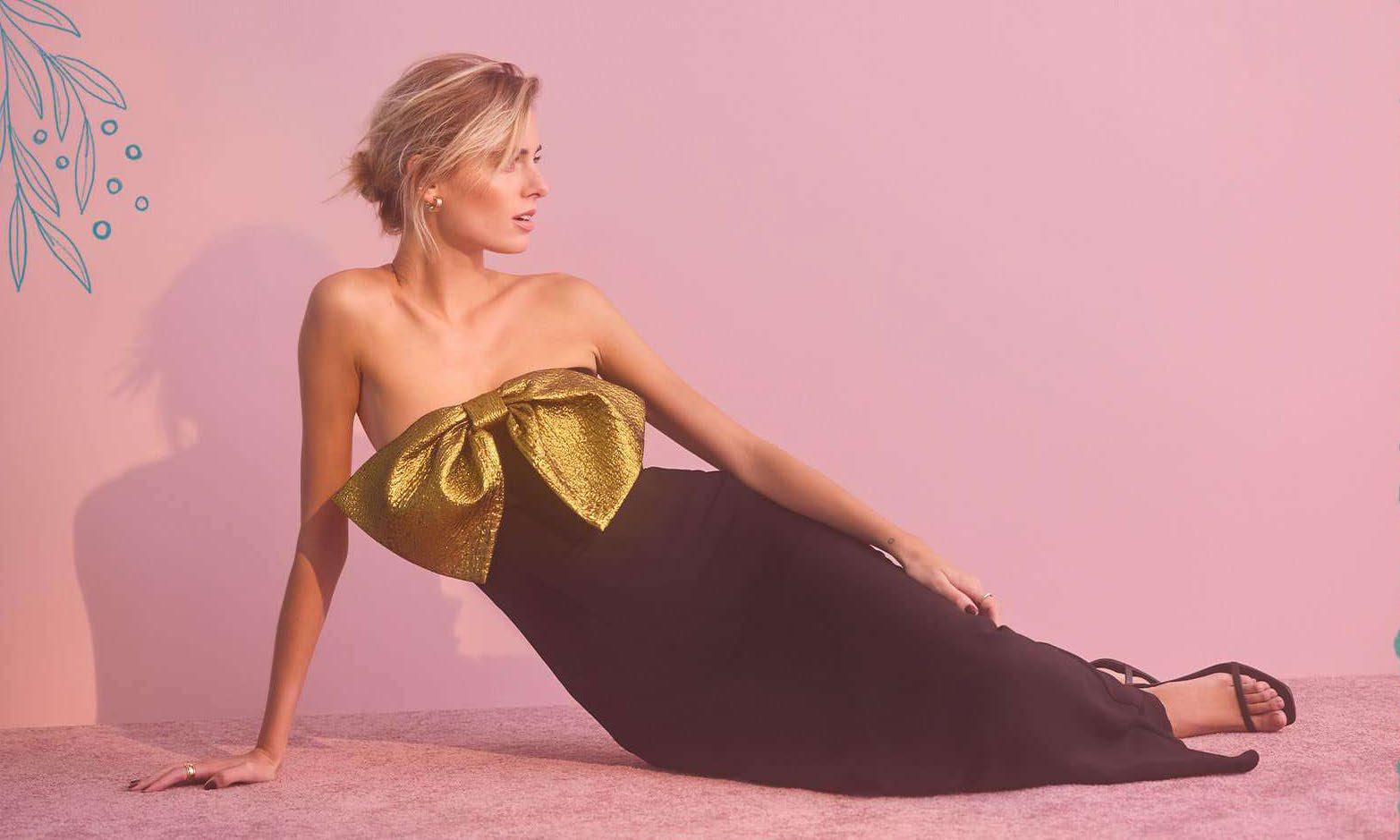
“Thanks,
is a phrase I heard all semester after giving friends a compliment. The premise of Nuuly is simple: pay $98 a month, choose and receive six items from popular brands such as Free People, For Love and Lemons, and Anthropology at the beginning of the month, return those items at the end of the month, and choose your six new items. These pieces are passed around from person to person all over the United States. The clothing subscription service has blown up in popularity over the past year. In a report by URBN, Nuuly had a 56% increase in subscribers in the first quarter of 2024, as compared to the first quarter
of 2023. This surge is happening for a good reason: Nuuly offers consumers an eco-friendly way to participate in trends and experiment with clothing without purchasing singlewear items which will end up in a landfill.
This service is perfect for consumers who want to minimize their environmental impact. Being a fashionenthusiast and eco-conscious can often be contradictory identities. The fashion-forward consumer wants to purchase new clothes to create outfits and try different styles, but the climate activist does not want to add to the problem of overconsumption and support unethical producers. Clothing subscription services allow people to truly commit to both identities.
By Bryna Jekogian ’25
Betsy Gross ’25, an environmental studies major, is subscribed to Nuuly because she felt that buying new clothing items was compromising her commitment to living sustainably. She sees the subscription as a way to participate in trends without contributing to environmental waste. American shoppers purchase, on average, 68 new items a year. These pieces are likely to be worn just seven times before being thrown out, as reported by the Wall Street Journal. Gross does not want her shopping habits to reflect this statistic. She knows just how harmful the fashion industry is to our environment. By renting used clothes and returning them for another person to wear, she is keeping clothes out of the landfill.
There are other ways to practice sustainability in fashion. One can only buy used clothes, donate their clothes, or participate in clothing swaps with friends. Clothing subscription services offer benefits over these options, such as the ability to participate in trends and the assurance that you are getting a quality piece of clothing from a reliable brand.

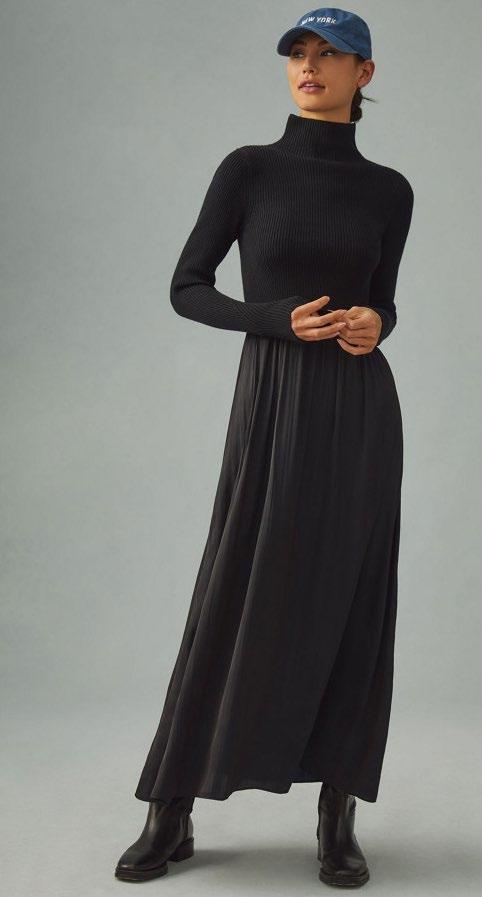
Admittedly, it is not a perfect option. Shipping the clothes contributes to pollution and the services are expensive. In a perfect world, people would be happy with fewer times of clothing and would not feel the need to buy new things. However, in the capitalist and consumerist world we live in, it is unreasonable to expect people to not conform to trends, not purchase a Halloween costume, or not want a new dress for a formal. Gross remarked that she knows that Nuuly does not provide a net-zero service. But, it allows her to revamp her existing closet without adding to the vicious cycle of fast fashion. Sustainability is not a one-size fits all solution, rather it should encourage us to find creative ways to live that meet the needs of the present without compromising the planet and its resources for future generations.

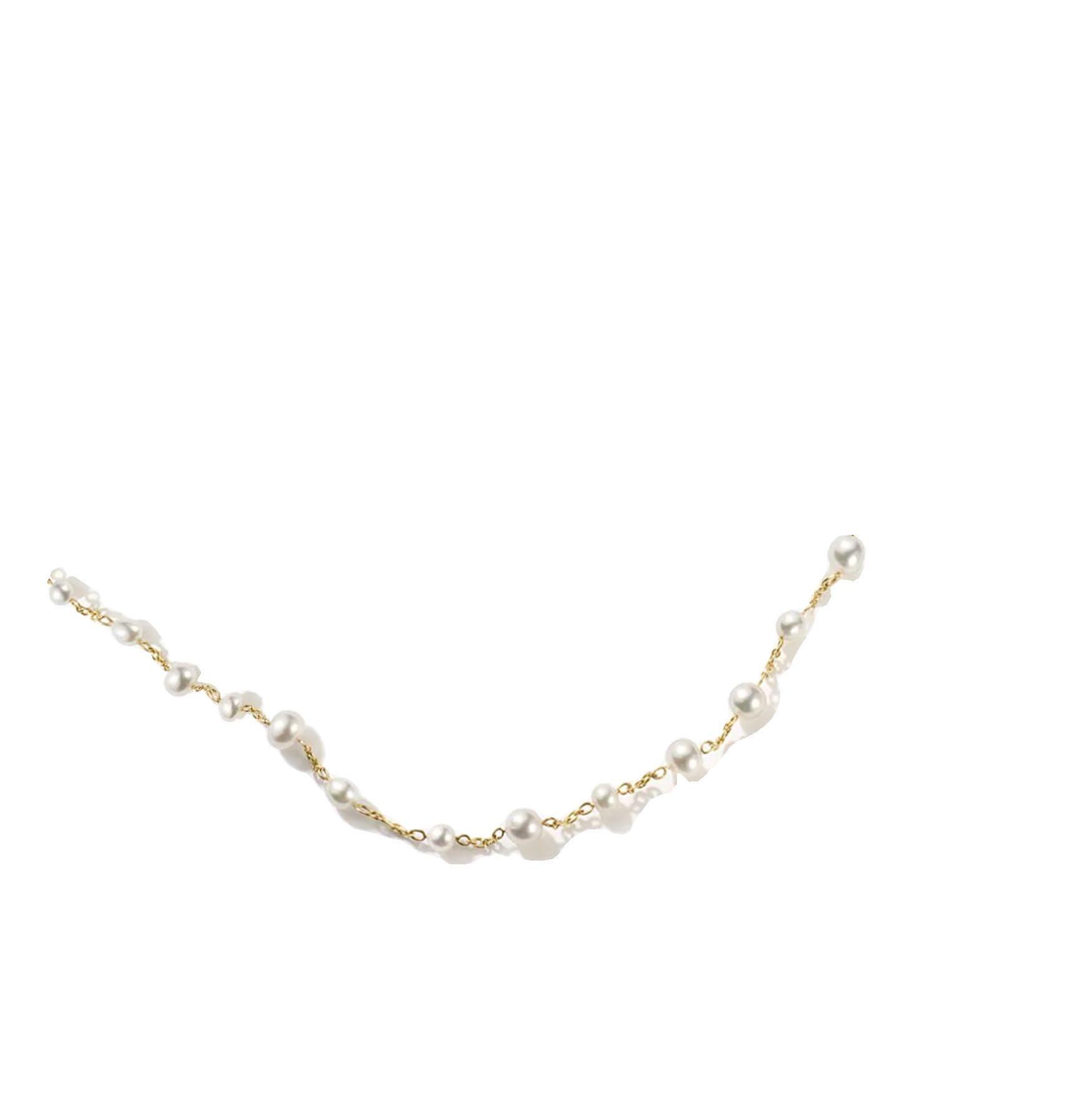


The intersectionality of feminism, sexism, and fashion is constant throughout the 2024 presidential campaign. From her fitting “coconut brown” pantsuit to the American flag pin on her lapel, Kamala Harris’s fashion choices are strongly representative of her presidential campaign. In comparison to her running mate
to call her “unprofessional” simply for what she wears. As Vogue remarks, Harris’ signature two-strand Irene Neuwirth pearl necklace has become a staple that ties in with her American flag pin. From her DNC appearance, to the black pantsuit in the September 10th debate against Trump,

Harris has reflected consistency and been a pillar of elegance for
While media’s attention has heightened on Harris’ fashion choices, Harris is not the first woman in the she would take attention away from him. Hilary Clinton’s hashtag #pantsuitnation
wearing pantsuits in a male dominated field—much like Harris is now. Harris’ style reflects her serious tone in the race to the White House, while still including
demonstrated by her Converse Chucks
Style is an aspect of stage presence, and coverage of the presidential election
CNN, and MSNBC. Harris’ femininity shines through her delicate accessories and the way she holds herself with poise on the debate and campaign trail. The reserved
professional and goal-oriented she is in the presidential race. The political runway is just another way Americans vote for their candidate, making fashion a key reason why we—fittingly—call the presidential race the
